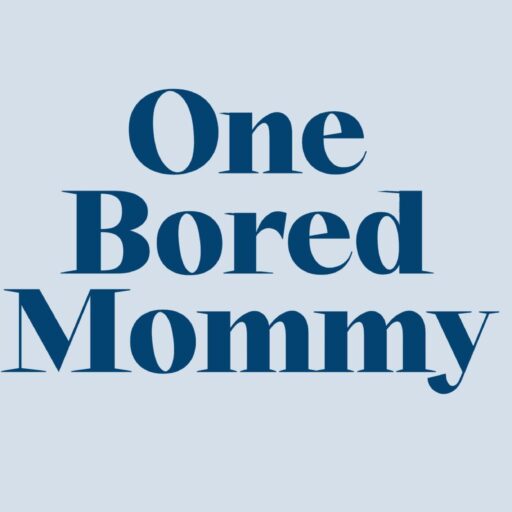Vetted
15 Best Books for Surviving the First Year of Parenthood – Expert Recommendations
Intrigued by the best books for surviving the first year of parenthood? Discover expert recommendations to navigate early parenthood with confidence.

Embarking on the **maze of early parenthood**, experts point to 15 top books for new parents. **‘What to Expect the First Year’** gives fresh advice, while **‘The Simplest Baby Book in the World’** shares no-nonsense tips. Try **‘Mayo Clinic Guide to Your Baby’s First Years’** for detailed facts. **‘We’re Parents! First-Time Dads Guide’** targets dads, and **‘Baby’s First Year: Memories for Life’** captures special moments. **‘Caring for Your Baby and Young Child’** offers wisdom up to age five. Check out **‘What to Expect the Second Year’** for ongoing support. These choices aim to guide, back, and empower new parents in the first-year adventure.
Key Takeaways
- Prioritize books with practical advice, emotional support, and developmental milestones for the first year.
- Look for resources aligned with parenting philosophy, values, language, and writing style.
- Consider cultural relevance, addressing common challenges, feeding, sleeping, development, and health topics.
- Opt for books organized chronologically, catering to individual parenting needs.
- Explore personal experiences to find resonant resources that align with parenting style and cultural beliefs.
What to Expect the First Year: (Updated in 2023)
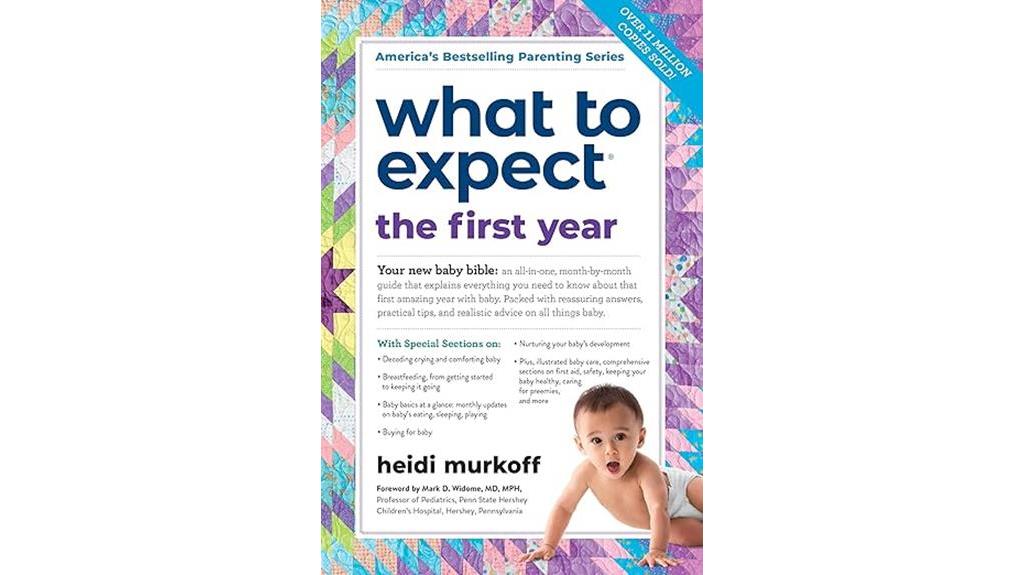
For those starting on the journey of parenthood, 'What to Expect the First Year: (Updated in 2023)' serves as an invaluable guide. This well-organized and informative book has received positive reviews from new mothers and healthcare professionals alike. It eases anxieties and helps mentally prepare parents for the first year of their baby's life.
The detailed month-by-month guide offers a thorough overview, covering all areas of interest. While the content may be dense for cover-to-cover reading pre-baby, the book features a soft hardcover that's easy to hold. Geared towards the American healthcare system, it provides a lot of information and is more suitable for reference than cover-to-cover reading.
Loved by first-time mothers, it's a useful source of information, even available in multiple languages like Spanish.
Best For: New mothers seeking a comprehensive and detailed guide for navigating the first year of their baby's life.
Pros:
- Well-organized and informative content
- Detailed month-by-month guide for the first year
- Loved by first-time mothers and recommended by healthcare professionals
Cons:
- Information may be too dense for cover-to-cover reading pre-baby
- More suitable for reference than cover-to-cover reading
- Geared towards the American healthcare system, may not fully align with other healthcare systems
The Simplest Baby Book in the World
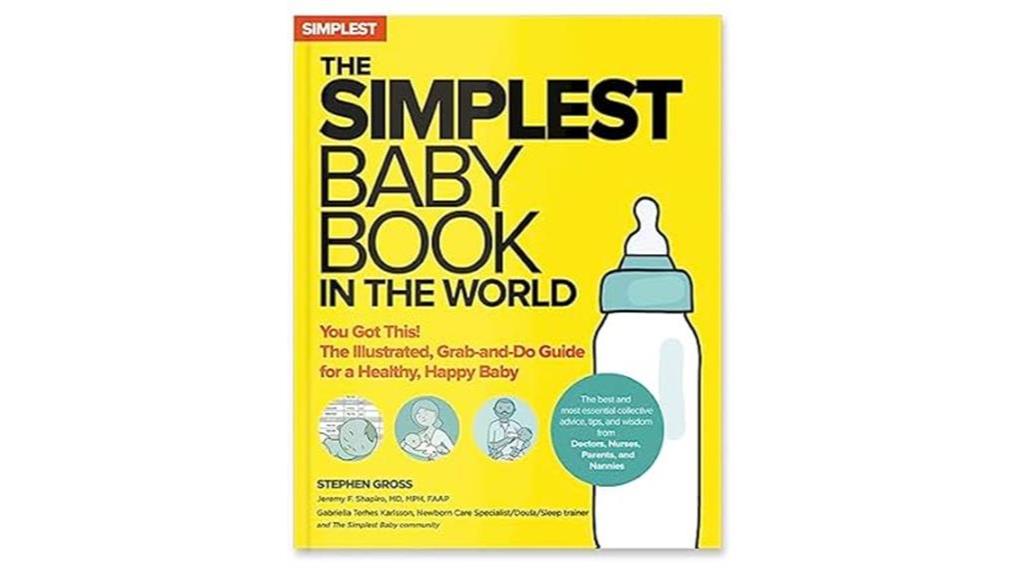
Ideal for new parents seeking straightforward guidance, 'The Simplest Baby Book in the World' provides essential care strategies and practical advice in an easy-to-follow format. This book has garnered overall positive feedback, with many praising its simplicity and helpfulness for first-time parents.
It covers basic and more involved care strategies in an easy-to-understand format with no-frills illustrations. The book includes important information for newborn care and lists 'must-haves' for each stage of growth. For new parents, it answers the majority of initial questions, saving time from internet searches and aiding in creating a baby registry.
Recipients appreciate its step-by-step guide, which boosts confidence and simplifies overwhelming information. Interestingly, it's described as a perfect gift for first-time parents, particularly new moms, due to its ease of understanding and practical advice.
Best For: New parents looking for a simple and practical guide to newborn care.
Pros:
- Provides essential care strategies and practical advice.
- Easy-to-follow format with no-frills illustrations.
- Boosts confidence and simplifies overwhelming information for first-time parents.
Cons:
- May not offer in-depth or specialized information for complex situations.
- Some readers may prefer more detailed illustrations or graphics.
- Limited focus on specific topics like health issues or developmental milestones.
Mayo Clinic Guide to Your Baby's First Years, 2nd Edition
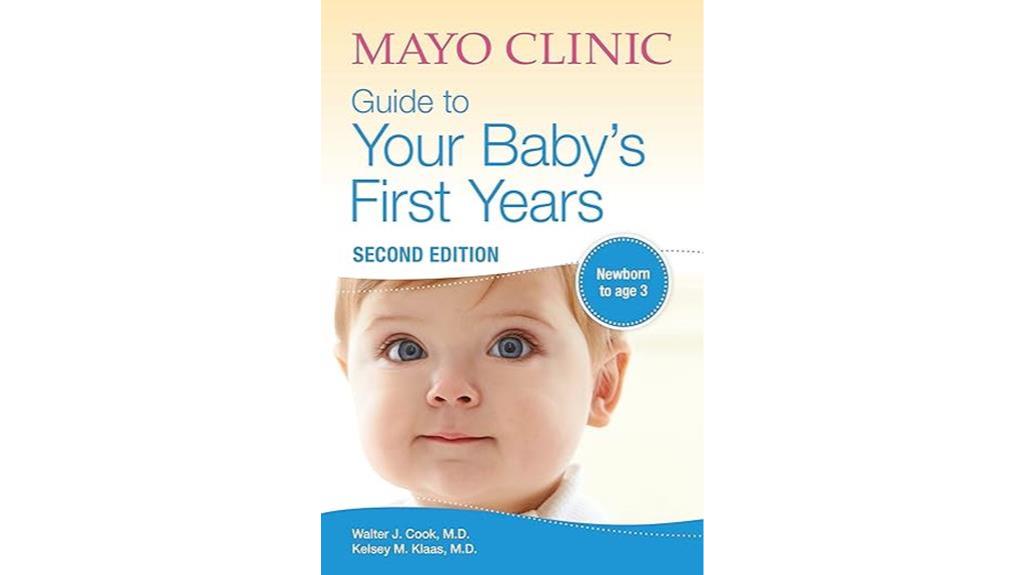
The Mayo Clinic Guide to Your Baby's First Years, 2nd Edition, is a detailed resource that equips new parents with practical, scientifically grounded information for managing the early stages of parenthood.
This guide is praised for its well-organized layout, making it easy to find information quickly. It presents intricate scientific knowledge in a simple and practical manner, ensuring that both mothers and birthing partners can benefit from its content.
The inclusion of illustrations and diagrams aids in understanding key concepts, while the summarized milestones for each month of a baby's development provide valuable insights into what to expect. Users appreciate that the book can be read selectively based on relevance, catering to individual needs.
Overall, it's described as a thorough and excellent reference for handling the challenges of the first year of parenthood.
Best For: New parents seeking a comprehensive and practical guide to navigate the early stages of parenthood with scientifically grounded information.
Pros:
- Well-organized layout for quick access to information.
- Scientifically grounded content presented in a simple and practical manner.
- Inclusion of illustrations and diagrams aids in understanding key concepts.
Cons:
- Some users may prefer more personal anecdotes or stories to complement the scientific information.
- Limited focus on specific cultural or individual parenting preferences.
- May not delve deeply into certain niche parenting topics.
We're Parents! First-Time Dads Guide to Babys First Year: Everything You Need to Know
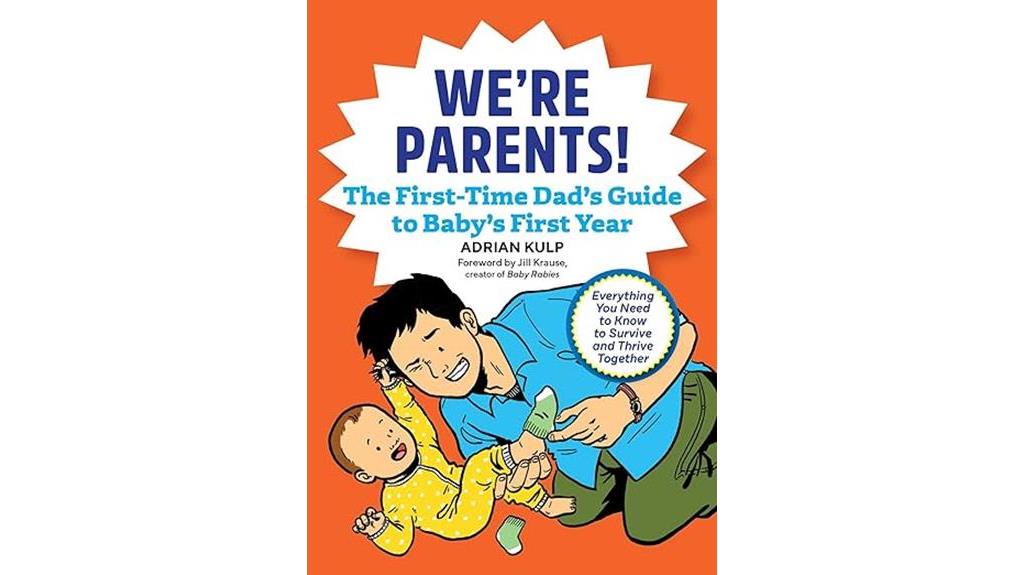
Recommended for overwhelmed new parents, 'We're Parents! First-Time Dads Guide to Baby's First Year: Everything You Need to Know' is a practical and friendly resource that offers guidance and support for dads maneuvering the challenges of the first year of parenthood.
This book has garnered positive reviews for providing good reminders and practical advice to help dads support both mom and baby effectively. Readers appreciate its easy-to-read format and find the humor, clarity, and useful tips especially beneficial for first-time fathers.
Personal experiences shared by readers indicate that the book aligns with their weekly parenting experiences and has helped couples navigate through tough weeks.
While some critics mention a focus on the American system and a slightly patronizing tone, the overall impact of this book is seen as highly beneficial for new parents seeking non-prescriptive, digestible advice.
Best For: New dads who are feeling overwhelmed and seeking practical advice and support during their baby's first year.
Pros:
- Recommended for overwhelmed new parents.
- Easy to read and understand, with practical advice.
- Loved by many for its simplicity and friendliness.
Cons:
- Some find the book overly focused on the American system.
- Described as strangely written and somewhat patronizing.
Babys First Year: Memories for Life – A Keepsake Journal of Milestone Moments
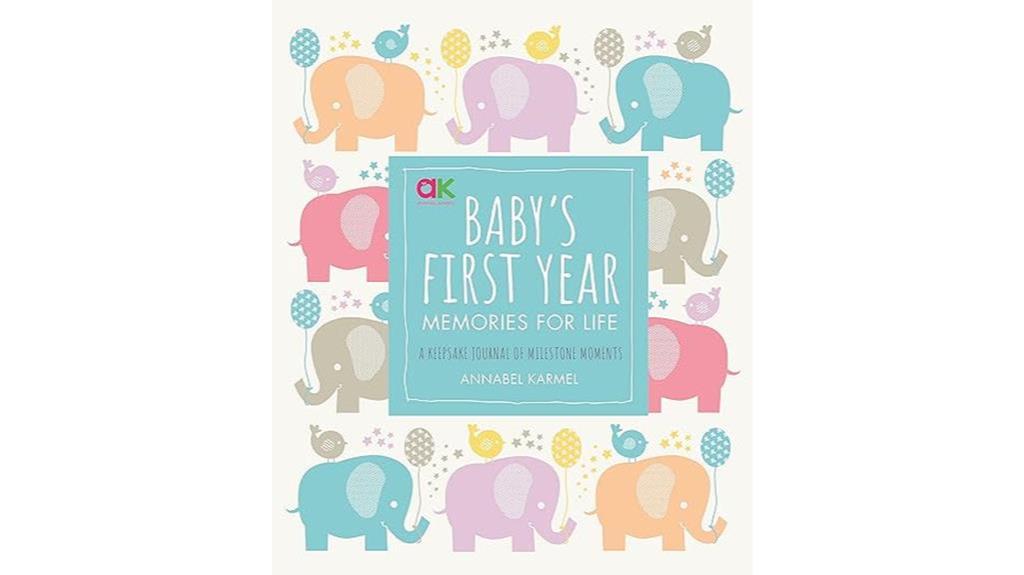
For parents seeking a practical and heartfelt way to document their baby's first year milestones, 'Baby's First Year: Memories for Life' offers a thorough and detailed tracking features. The book's user-friendly prompts make it easy to record important moments without feeling overwhelmed.
With appealing colors, charming designs, and personalized quotes from the author, this journal adds a special touch to capturing memories. From monthly photo spots with space for length and weight to dedicated pages for first foods and bath time, every aspect of a baby's growth is covered.
Users appreciate its extensive nature and find it great for tracking milestones, including those precious first teeth. 'Baby's First Year: Memories for Life' isn't just a journal but a sentimental keepsake that families cherish, making it a popular choice for baby shower gifts and generational use.
Best For: Parents who want a comprehensive and visually appealing way to document their baby's first year milestones.
Pros:
- Easy-to-use prompts for recording important moments without feeling overwhelmed.
- Appealing colors, charming designs, and personalized quotes add a special touch.
- Comprehensive tracking features cover all aspects of a baby's growth, including first teeth milestones.
Cons:
- Some users may find the book too detailed or time-consuming to fill out completely.
- Limited customization options for those looking for a more personalized journal experience.
- Price point may be higher compared to other baby milestone journals on the market.
Parenting Guide for Toddlers: Surviving the Toddler Years
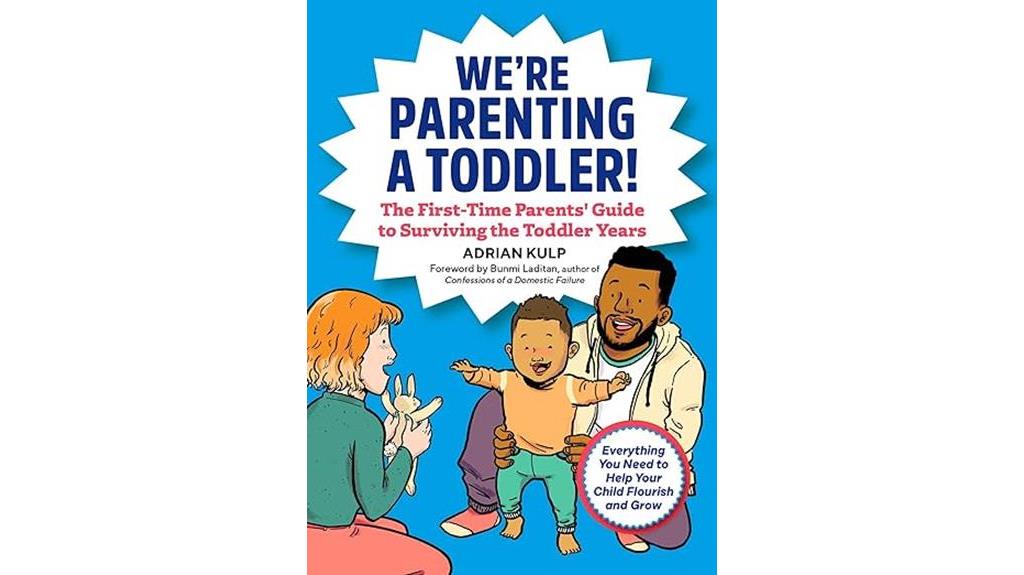
When seeking a relatable and practical parenting guide tailored to maneuvering through the unpredictable toddler years, consider the insights shared in the 'Books for Surviving the First Year of Parenthood.'
This book, while recommended, comes with a caution that it reflects one family's experience, so not all sections like sleeping and potty training may resonate with every parent. Criticisms include illustrations not matching the quality of information provided and a lack of structured flow that makes it challenging to apply advice to specific toddler ages.
However, the book's casual and friendly presentation of anecdotes and suggestions is praised, offering reassurance to parents. Its emphasis on avoiding perfection, understanding individual differences in children, and promoting a relaxed parenting approach has garnered appreciation.
Despite mixed reviews on structure and practicality, the book is commended for its relatable, funny, and realistic take on the toddler experience.
Best For: Parents seeking a relatable and humorous perspective on navigating the challenges of toddlerhood.
Pros:
- Personal and practical advice for real-life situations.
- Encourages a more relaxed and present parenting approach.
- Emphasis on understanding and accepting individual differences in children.
Cons:
- Lack of structured flow may make it challenging to apply advice to specific toddler ages.
- Illustrations criticized for not matching the quality of information provided.
- Some sections may not resonate with all parents, especially regarding sleeping and potty training.
Dr. Careys Baby Care: First Year Baby Care Guide

Dr. Careys Baby Care: First Year Baby Care Guide is a must-have for first-time parents managing the challenges of the initial year of parenthood. This all-encompassing guide covers essential topics like baby sickness and diaper rashes, offering valuable insights on when to seek medical assistance.
The book's easy-to-understand content, coupled with helpful images, has garnered praise from readers who find it informative and reassuring. Described as a life-saver, Dr. Careys Baby Care Guide provides clarity on common baby conditions, boosting parents' confidence in caring for their little ones.
With practical advice and reliable information from a pediatrician, this book has become a go-to resource for many, surpassing internet searches in accuracy and anxiety reduction. For new moms seeking guidance and reassurance, this book comes highly recommended for its in-depth coverage and practicality in maneuvering the first year of parenthood.
Best For: First-time parents seeking a comprehensive and practical guide for navigating the challenges of their baby's first year.
Pros:
- Covers various potential baby issues like sickness and diaper rashes.
- Provides guidance on when to seek medical help.
- Easy-to-understand content with helpful images for reference.
Cons:
- May not provide in-depth information on more rare or complex baby conditions.
- Some readers may find the content repetitive if they already have prior knowledge or experience.
- The book may lack specific guidance tailored to individual parenting styles or preferences.
The Wonderful Baby You Are: A Record of Baby's First Year Memory Book
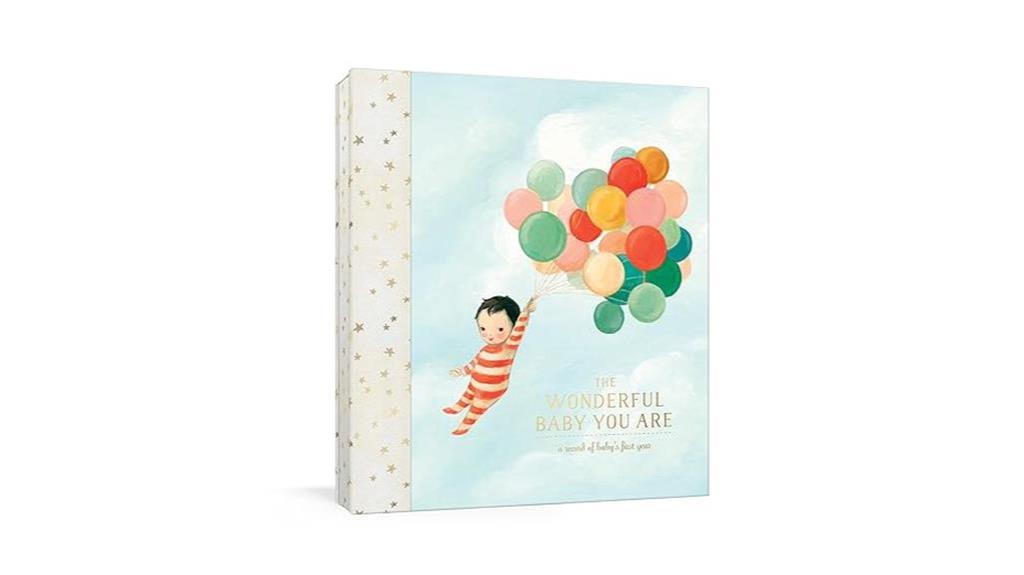
The 'Books for Surviving the First Year of Parenthood' is a must-have for parents looking to beautifully document their baby's first year memories with a gender-neutral and elegantly designed record book like 'The Wonderful Baby You Are'.
This memory book features gender-neutral illustrations and plenty of space for pictures and keepsakes, making it a delightful way to cherish and share those precious moments. Users have praised the book's quality, design, and customization options for milestone pages. It includes sections from pre-pregnancy to the baby's first year, with little pockets for storing special items.
While some users have reported binding issues, many find it ideal for first-time parents and appreciate its elegant and minimalist design. Consider 'The Wonderful Baby You Are' for a thoughtful baby shower gift or a personal keepsake to treasure for years to come.
Best For: Parents seeking a gender-neutral and elegantly designed memory book to beautifully document their baby's first year memories.
Pros:
- Gender-neutral illustrations and elegant design
- Plenty of space for pictures and keepsakes
- Customizable milestone pages
Cons:
- Some users reported binding issues
- May not be ideal for those looking to paste numerous pictures
- Durability of the binding may be a concern
The New Father: A Dads Guide to the First Year
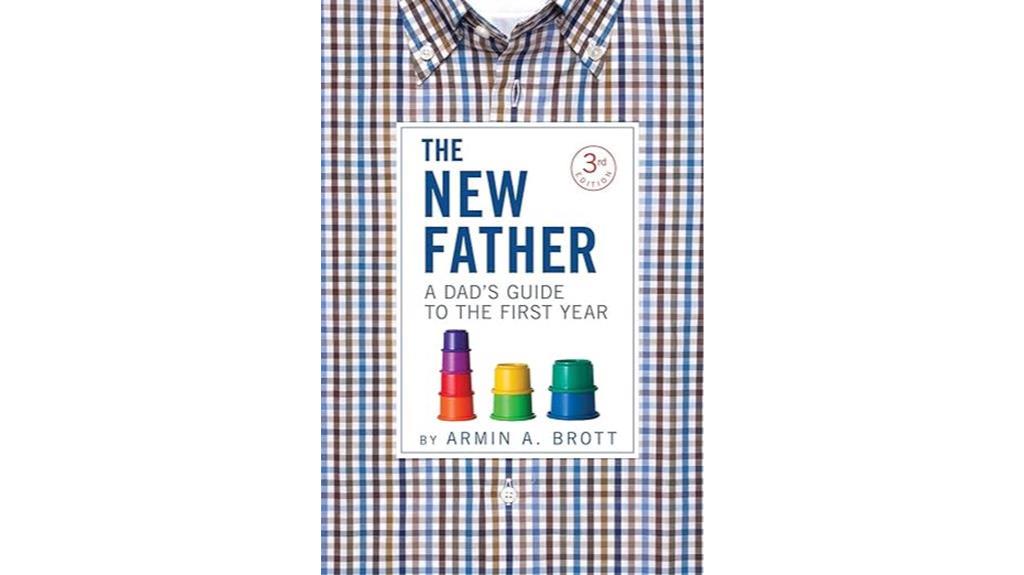
Best suited for new fathers facing the challenges of the first year of parenthood, 'The New Father: A Dad's Guide to the First Year' offers practical advice and emotional support. This book has been praised for its warm and relatable tone, covering a wide range of topics from diaper changing tips to understanding the emotional complexities of fatherhood.
It stands out for its all-encompassing approach, providing insights on personal changes and relationship dynamics. Readers have found it to be an informative and engaging resource, boosting their confidence and enhancing their understanding of parenting.
The clear and concise writing style, along with the balance of humor and seriousness, makes it an engaging and valuable guide for new fathers seeking guidance in their parenting journey.
Best For: New fathers navigating the challenges of the first year of parenthood seeking practical advice and emotional support in an engaging and relatable format.
Pros:
- Comprehensive coverage of practical parenting aspects and emotional complexities.
- Clear and concise writing style with a balance of humor and seriousness.
- Boosts confidence and enhances understanding of parenting, fostering communication between partners.
Cons:
- May not delve deeply into specific niche parenting topics.
- Some readers might prefer more in-depth personal anecdotes.
- Limited focus on diverse family structures and cultural perspectives.
The Ultimate Baby Book for New Dads
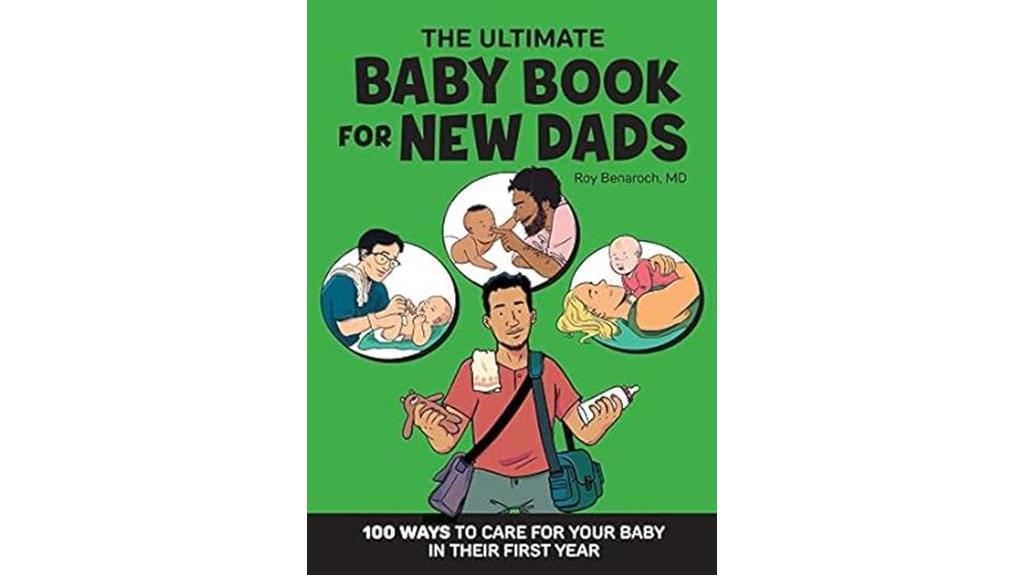
For new dads maneuvering the challenges of parenthood in the first year, 'The Ultimate Baby Book' offers valuable and accessible guidance.
This compact book may have smaller print, but its content is packed with practical advice tailored specifically for new fathers. The organization by months makes it easy to navigate, and the inclusion of pictures aids quick reference.
From learning about essential tasks like burping and diaper changing to decoding the mysteries of baby poop, this book covers a wide array of topics important for new dads.
While some dads found the tone a bit patronizing, many appreciated the simplicity, humor, and informative nature of the book. Overall, 'The Ultimate Baby Book' seems to be a handy companion for dads seeking to navigate the nuances of caring for their little ones in the first year.
Best For: New dads looking for a compact, informative, and easy-to-use guide on caring for their newborn in the first year.
Pros:
- Organized by months for easy navigation
- Contains valuable information on essential baby care tasks
- Includes illustrations and interactive activities for an engaging reading experience
Cons:
- Some may find the tone of the book to be slightly patronizing
- The print is small, which may be challenging for some readers
- Not suitable for experienced parents or those looking for in-depth parenting advice
My First Book of Baby Signs: 40 Essential Signs to Learn and Practice
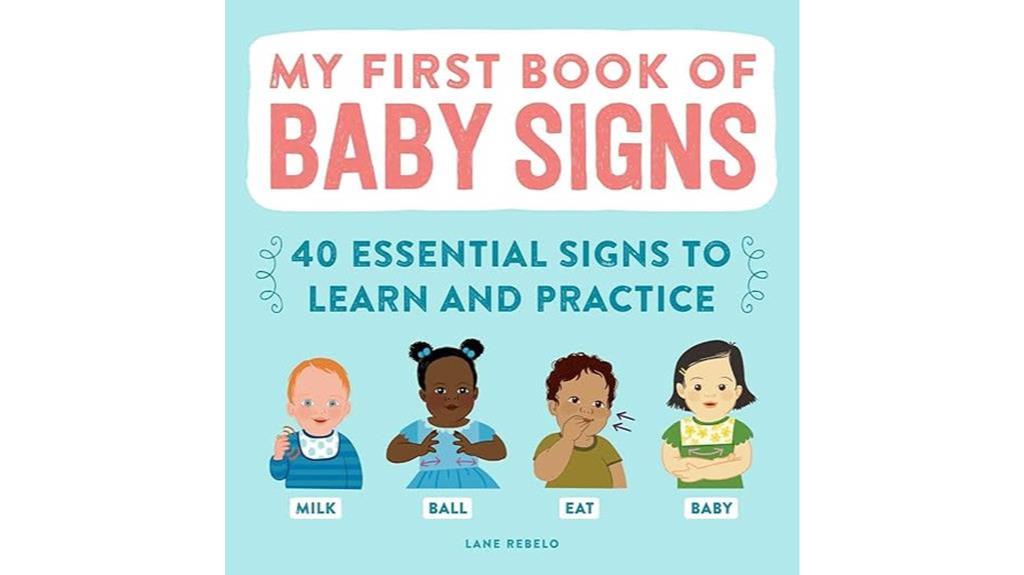
Ideal for new parents seeking to enhance early communication with their babies, 'My First Book of Baby Signs: 40 Essential Signs to Learn and Practice' provides a straightforward and practical approach to introducing sign language. With its clear pictures and simple layout, this book is well-received by beginners for its quality and effectiveness in teaching babies essential signs.
Many users commend the inclusivity in the illustrations, showcasing diversity. Parents find this book helpful in facilitating early communication and reducing frustration for both themselves and their babies. The book's impact is evident as babies quickly pick up the signs, improving overall communication efficiency.
While some users mention concerns about the book's physical durability, its educational value and ease of use make it a recommended resource for teaching sign language to babies, endorsed even by speech therapists for its engaging content and positive outcomes.
Best For: Parents and caregivers looking to teach their babies essential sign language skills in a simple and effective manner.
Pros:
- Clear pictures and arrows facilitate easy understanding of sign language.
- Helps babies communicate early, reducing frustration for both parties.
- Babies quickly pick up the signs, enhancing overall communication efficiency.
Cons:
- Some users have noted concerns about the book's physical durability.
- Packaging issues have been reported, such as folded covers upon delivery.
- Lack of clarity on American Sign Language (ASL) may disappoint some users.
What to Do When Youre Having Two: The Twins Survival Guide

Ideal for new parents of twins, 'What to Do When You're Having Two: The Twins Survival Guide' offers practical advice and real-life experiences for managing the unique challenges of raising multiples. Written by Natalie Diaz, this thorough guide addresses a wide range of topics, from pregnancy through the first year of parenting twins.
Readers appreciate the book's easy-to-read format and well-organized content, finding it to be a valuable resource in preparing for the arrival of twins. Diaz's approach, characterized by humor, compassion, and support, resonates with many readers, instilling confidence and providing practical tips for handling the twin journey.
While some readers note contradictions in the book's messages or its alignment with their parenting style, overall, 'What to Do When You're Having Two' is highly recommended for its humor, honesty, and helpful information, making it a must-have for future parents of twins.
Best For: Expectant parents of twins seeking a comprehensive and supportive guide for navigating the challenges of raising multiples.
Pros:
- Provides practical advice and real-life experiences specific to parenting twins.
- Author's humorous and compassionate approach resonates with readers, instilling confidence.
- Well-organized content and easy-to-read format make it a valuable resource for preparing for twins.
Cons:
- Some readers may find certain messages contradictory or not aligned with their parenting style.
- Repetitive mentions of the author's website may be frustrating for some readers.
- Not all readers may find the additional resources as helpful as others.
Caring for Your Baby and Young Child, 7th Edition: Birth to Age 5
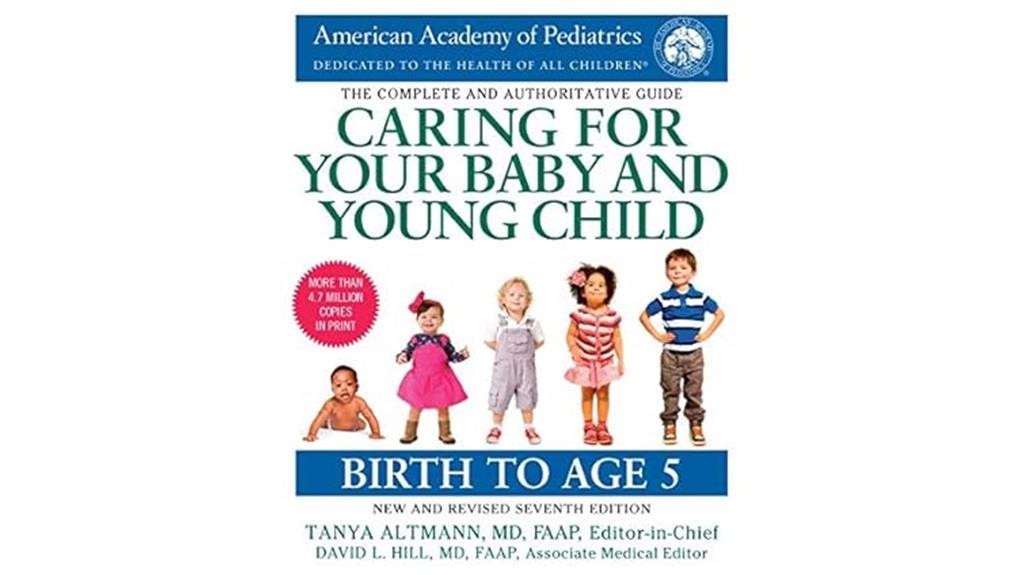
Containing valuable information on developmental milestones, child health, and practical advice, this book is a must-have resource for new and experienced parents alike. The 7th edition of 'Caring for Your Baby and Young Child' covers a wide range of topics, from understanding your child's growth and development to providing guidance on common childhood illnesses.
With clear and simple language, this book offers insights into menu ideas, illness identification, and when to seek professional medical help. While some readers suggest additional research for more in-depth knowledge on specific subjects, the majority praise the book for its thorough approach to child care.
Whether you're a first-time parent seeking guidance or a grandparent looking to brush up on child care practices, this book comes highly recommended as a valuable addition to your parenting library.
Best For: Parents and caregivers seeking a comprehensive guide on child health, development, and practical advice from birth to age 5.
Pros:
- Covers a wide range of topics related to child care and development.
- Written in clear and simple language for easy understanding.
- Offers practical advice and guidance on common childhood illnesses.
Cons:
- May require additional research for more in-depth knowledge on specific subjects.
- Some complaints about packaging quality and condition upon delivery.
- Criticism about the use of pronouns in the book.
Babys First Year Book, Minimalist Baby Book Keepsake

For first-time mothers looking to document and cherish their baby's milestones, the Baby Love Journal by Pure Heart is a modern and minimalist baby memory book that provides a beautiful keepsake.
This 11×8.5-inch hardcover book features dedicated monthly sections, parenting guidance, and space for 31 photos and 16 Polaroids.
With 88 full-color pages adorned with illustrations, linen cloth, and gold foil accents, it's designed to capture and celebrate precious moments.
The care tips included promote longevity and elegance, emphasizing delicate handling, proper storage, and picture optimization.
The Baby Love Journal is an ideal choice for preserving memories and creating a lasting treasure that beautifully encapsulates your baby's first year.
Best For: Parents who value a modern and minimalist approach to preserving and celebrating their baby's milestones.
Pros:
- Dedicated monthly sections and parenting guidance for organized documentation.
- Space for 31 photos and 16 Polaroids to capture precious memories.
- Care tips included for longevity and elegance, ensuring the book remains a lasting treasure.
Cons:
- Limited customer reviews available at the time of assessment.
- Product may have a higher price point compared to other baby memory books.
- Manufacturer's warranty terms and coverage may not be explicitly stated.
What to Expect the Second Year: From 12 to 24 Months
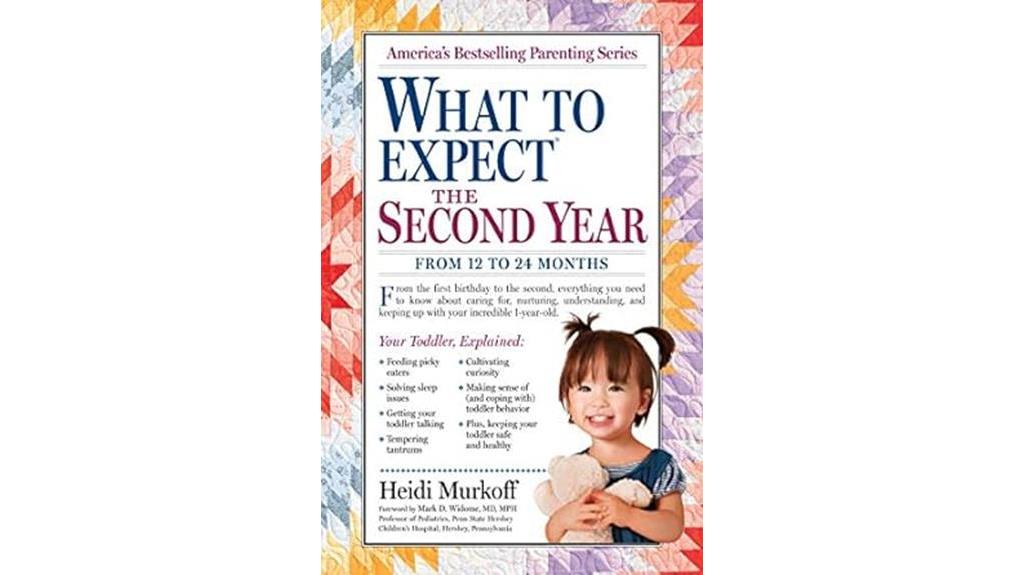
The second-year book from 'Books for Surviving the First Year of Parenthood' is an essential resource for parents seeking guidance on guiding their child's development from 12 to 24 months. This book has garnered positive reviews from professional nannies and parents alike, highlighting its practical advice for childcare and parenting. The comments also commend the book's condition upon delivery, ensuring a pleasant reading experience.
Compared to the first-year book, the second-year edition is well-organized into categories such as sleeping, feeding, and playing, making it easy to browse. Personal experiences shared by users emphasize the book's thoroughness in addressing common toddler issues like tantrums, teeth brushing, and developmental milestones.
Its insights, readability, and relevance to parenting make it a valuable resource, especially for first-time parents progressing through the second year of their child's life.
Best For: First-time parents navigating the challenges and joys of their child's second year of life.
Pros:
- Well-organized content by categories like sleeping, feeding, and playing.
- Comprehensive coverage of common toddler issues such as tantrums and developmental milestones.
- Practical advice and insights for parenting that are relevant and readable.
Cons:
- Limited focus on specific cultural differences in parenting practices.
- May not delve deeply into language preferences for non-English readers.
- Some readers may find the book's structure repetitive if compared to the first-year edition.
Factors to Consider When Choosing Books for First Year of Parenting

When choosing books for the first year of parenting, it's important to take into account factors like:
- The selection criteria
- Parenting focus
- Practical guidance
- Personal experiences
- Cultural relevance
These elements can play a significant role in how beneficial a book will be in guiding the challenges of early parenthood.
Selection Criteria
Consider various factors when selecting books for the first year of parenting to make sure they align with your needs and preferences.
Firstly, look at the book's organization. Determine if it offers month-by-month guidance or if it's structured by topics for quick reference.
Next, seek a book that strikes a balance between practical advice, emotional support, and outlining developmental milestones.
Thirdly, confirm the book aligns with your parenting philosophy and values to guarantee its relevance and applicability to your situation.
Additionally, evaluate the language and writing style of the book. Clarity, engagement, and ease of understanding are important for effective communication.
Lastly, consider any cultural or language differences that could impact how you interpret and utilize the book's content.
Parenting Focus
For new parents starting out on their journey, it's important to prioritize selecting books that focus specifically on the first year of parenting. When choosing a book for the first year of parenthood, it's vital to think about if the content is tailored to this specific period.
Look for books that explore the common challenges and milestones that arise during the initial year of parenting, offering practical advice and solutions. Make sure the book covers a wide array of topics relevant to the first year, including feeding, sleeping, development, and health.
It's beneficial to opt for a book that's structured chronologically, providing guidance month by month to align with your journey through the first year. Additionally, consider your individual needs as a parent, whether you're a first-time parent, a parent of multiples, or seeking information on a particular aspect of parenting in the first year.
Practical Guidance
When choosing books for the first year of parenting, prioritize practical guidance that covers essential topics like feeding, sleeping, and diapering.
Look for resources that offer advice on everyday challenges such as baby care, developmental milestones, and health concerns to assist you in managing the initial stages of parenthood.
Opt for books with easy-to-follow tips and strategies for dealing with common issues that arise during the first year, including teething, colic, and growth spurts.
Seek out insights on establishing routines, fostering bonding, and promoting your baby's well-being in the early months of their life.
Consider selecting books that cater to your specific concerns and preferences, whether they focus on a holistic parenting approach, practical tips, or evidence-based recommendations for infant care.
Personal Experiences
Exploring personal experiences with parenting books can offer valuable insights into finding the right resources for maneuvering through the first year of parenthood. As a new parent, I discovered that different books resonated with me based on my specific needs and parenting style.
Some books provided practical tips that aligned well with my daily routines, while others delved into the emotional aspects of parenting, offering comfort during challenging times. It became evident that the effectiveness of a parenting book is highly individualized, influenced by factors such as cultural beliefs, personal challenges, and the author's writing style.
Hearing about other parents' experiences with various books helped me narrow down my choices and select resources that addressed my concerns. When considering a parenting book, weighing personal experiences and reviews is crucial to make sure the content meets your expectations and supports your parenting journey effectively.
Cultural Relevance
Understanding the cultural relevance in parenting books is essential for aligning advice with beliefs, practices, and traditions. Different cultures may influence how parents approach various aspects of child-rearing, such as discipline, feeding, and developmental milestones.
By choosing books that incorporate diverse cultural perspectives, parents can access information that resonates with their background and experiences. Considering cultural nuances can help navigate challenges and make decisions that align with one's cultural values.
Books that acknowledge and respect cultural diversity can enhance the parenting journey by offering relevant and meaningful guidance. These resources not only provide practical tips but also validate the importance of cultural identity in shaping parenting practices.
Language Considerations
Taking into account language preferences is crucial when selecting books for the first year of parenthood. It guarantees easy understanding and effective communication within the family. It's important to choose books that are available in the language you're most comfortable with to guarantee clarity and comprehension.
If your family speaks multiple languages, consider books that offer translations or glossaries for unfamiliar terms to cater to everyone's needs. This is particularly significant for non-native speakers to make sure the content is relatable and easily digestible.
Additionally, selecting books that align with your cultural background can enhance the relevance and applicability of the information provided. By paying attention to language considerations, you can create a nurturing environment where communication flows smoothly, and everyone can engage with the material in a meaningful way.
Book Organization
Considering the organization of books is vital when choosing resources for managing the first year of parenting efficiently. Opt for books that follow a month-by-month structure to provide a clear timeline of your baby's development. This layout can help you anticipate milestones and changes as your little one grows.
Look for books that categorize information into sections such as feeding, sleeping, and developmental milestones. This organization makes it easier to find the specific advice you need at any given time. A structured layout with dedicated sections for common concerns and tips for each stage can also be beneficial.
Choose books that offer a systematic approach to addressing the various aspects of your baby's first year. Make sure that the book provides guidance in a logical sequence to help you navigate the different challenges and joys you may encounter throughout this important first year of parenthood.
User Recommendations
When selecting books for the first year of parenting, I find user recommendations to be invaluable in guiding my choices based on practical feedback and real-world experiences. User recommendations offer insights from individuals who've actually used the books during their parenting journey. These recommendations provide feedback on the relevance, usefulness, and impact of the books, highlighting specific features or content that stood out to them.
By considering user recommendations, prospective readers can make informed decisions about which books to choose for their first year of parenting. These real-world perspectives help in understanding the benefits and potential drawbacks of different parenting books, allowing for a more personalized selection based on the experiences of others.
Ultimately, user recommendations serve as a valuable resource in exploring the vast array of parenting books available, offering practical guidance and insights for those starting on the journey of parenthood.
Frequently Asked Questions
What Are Some Unique Ways to Document My Baby's First Year?
One unique way to document your baby's first year is by creating a monthly photo series in a specific setting or with a prop that shows growth over time.
Another idea is to keep a journal where you jot down special moments, milestones, and memories.
Additionally, you could make a time capsule with items like a favorite toy, a cute outfit, and a handwritten note to be opened on a significant future date.
How Can I Prepare for Parenting Twins in the First Year?
Preparing for parenting twins in the first year involves creating a solid support system, establishing routines, and organizing essentials like diapers and clothing in advance.
Setting up a feeding and sleeping schedule can help manage the day-to-day challenges. Investing in double strollers and cribs is practical.
Joining twin parenting groups for advice and connecting with other parents of twins can provide valuable insights and emotional support throughout this unique journey.
Are There Specific Books for Dads to Navigate the First Year?
Embarking on the first year as a dad can be both exciting and overwhelming. While many parenting books cater to moms, there are also fantastic resources tailored specifically for dads.
These books offer practical advice, emotional support, and insights on fatherhood's unique challenges.
From 'The Expectant Father' to 'Dude, You're Gonna Be a Dad,' these reads can help dads feel prepared, informed, and connected during the whirlwind of the first year of parenthood.
What Are Essential Signs to Learn for Baby Communication?
Learning essential signs for baby communication is vital for caregivers. Starting with basic signs like 'more,' 'milk,' and 'all done' can enhance early interactions.
Observing cues such as eye contact, gestures, and sounds aids in understanding the baby's needs. Paying attention to non-verbal signals like crying patterns and body language further deepens communication.
These skills foster strong bonds and help caregivers respond effectively to their baby's needs.
How Can I Choose the Best Book for My Baby's First Year?
When selecting a book for your baby's first year, consider reputable authors and reviews. Confirm that the content aligns with your parenting style and covers essential topics like feeding, sleeping, and development.
Look for books that offer practical advice and are easy to understand. Remember, the best book is one that resonates with you and addresses your concerns effectively.
Trust your instincts as a parent; finding the right book is like finding a trusted advisor on this incredible journey.
Are the books recommended for surviving the first year of parenthood also helpful for navigating the journey of parenthood in general?
Looking for the best parenting books to guide you through the journey of parenthood? The books recommended for surviving the first year of parenthood can also be incredibly helpful for navigating the challenges and joys of parenthood in general. These books offer valuable insights and practical tips for every stage of the parenting journey.
Conclusion
In the whirlwind of the first year of parenthood, these 15 books will be your lifeline, guiding you through the ups and downs of raising a child with expert advice and heartfelt wisdom.
Just like a compass in a storm, these books will help you navigate the unpredictable journey of parenting, providing support, knowledge, and reassurance along the way.
Embrace the challenges, cherish the moments, and remember, you're never alone on this incredible adventure.
Vetted
14 Best Self-Help Parenting Books Every Parent Should Read for a Happier Family
Leverage the power of self-help parenting books to transform your family dynamics and cultivate a happier home – discover essential insights and strategies within!

**Hunting for a happier family?** Check out the ’14 Best Self-Help Parenting Books’ for practical advice and smart strategies. Books like ‘How to Stop Losing Your Sh\*t with Your Kids,’ ‘Raising Good Humans,’ and ‘Parenting from the Inside Out’ help with building self-awareness, mindful parenting, and personal growth. Also, ‘The 7 Habits of Highly Effective Teens,’ ‘Moms Moving On,’ and ‘Teen Girls Survival Guide’ offer extra support. These guides provide tools to handle tough times and improve family vibes. They aim to give parents a richer, more joyful parenting journey.
Key Takeaways
- Consider author credentials and expertise for credible advice.
- Select books with practical strategies and tangible techniques.
- Look for alignment with your parenting style and values.
- Choose books that offer actionable advice for specific challenges.
- Prioritize books that foster personal growth and positive parenting practices.
How to Stop Losing Your Sh*t with Your Kids: A Practical Guide to Becoming a Calmer, Happier Parent

For parents seeking practical solutions to manage stress and improve their parenting skills, 'How to Stop Losing Your Sh*t with Your Kids' offers valuable insights and strategies. This book has garnered positive reviews for its relatable and easy-to-understand content. Readers appreciate the author's humorous acronyms and conversational tone, making the advice both helpful and engaging.
The author's writing style is described as honest and compassionate, resonating well with readers looking for realistic solutions to parenting challenges. Additionally, the book's focus on self-awareness and self-control has helped many readers gain a new perspective on their parenting approach.
While some critiques mention the lack of addressing men's roles in parenting and concerns about language use, overall, 'How to Stop Losing Your Sh*t with Your Kids' seems to have a positive impact on readers' self-perception and parenting skills.
Best For: Parents looking for a practical and humorous guide to improve their parenting skills and reduce stress levels.
Pros:
- Relatable and easy-to-understand content.
- Author's humorous acronyms and conversational tone keep readers engaged.
- Emphasis on self-awareness and self-control for personal growth in parenting.
Cons:
- Lack of addressing men's roles in parenting.
- Some readers find the language disrespectful towards children.
- Organizational issues mentioned by some critiques.
Raising Good Humans: A Mindful Guide to Breaking the Cycle of Reactive Parenting
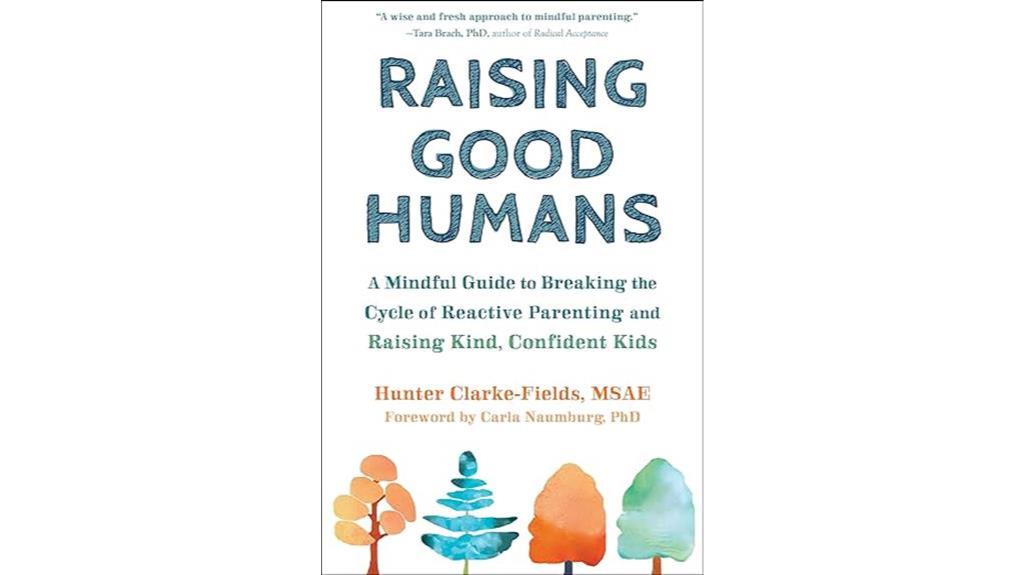
'Raising Good Humans: A Mindful Guide to Breaking the Cycle of Reactive Parenting' offers practical strategies for transforming parenting habits and fostering healthier family dynamics. This book has garnered positive reviews and recommendations from readers who found it insightful and valuable.
Many parents, especially first-timers, appreciate the engaging way it delivers essential information. Readers highlight the importance of self-work and patience in parenting, emphasizing its impact on parenting approaches. By providing effective strategies, the book helps parents handle challenging moments with children and break the cycle of reactive parenting.
While some readers faced challenges unlearning their upbringing, the emphasis on self-work and mindfulness practices proves beneficial. Personal experiences shared reveal how the book aids in identifying triggers, working through underlying issues, and promoting self-reflection for improved parenting.
Specific techniques like I language and win-win discussions, alongside mindfulness practices, equip parents to tackle parenting challenges more effectively.
Best For: Parents seeking to break the cycle of reactive parenting and cultivate mindful and effective parenting practices.
Pros:
- Insightful and valuable information presented in an engaging manner.
- Effective strategies for handling challenging moments with children.
- Encourages self-work, mindfulness practices, and self-reflection for improved parenting.
Cons:
- Some readers may find unlearning their upbringing challenging.
- Initial difficulty in approaching mindfulness practices for a few readers.
- The emphasis on self-work and patience in parenting may require a significant commitment.
Parenting from the Inside Out: How a Deeper Self-Understanding Can Help You Raise Children Who Thrive
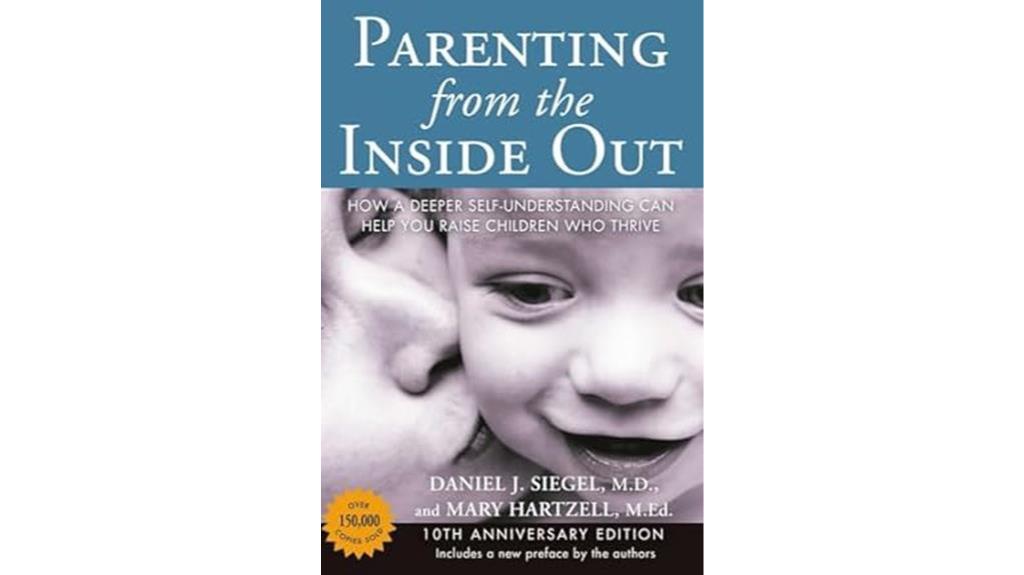
In my experience, 'Parenting from the Inside Out' is a transformative read for individuals seeking to understand themselves deeply while nurturing thriving children. This book explores the connection between a parent's own emotional experiences and their parenting style, emphasizing the importance of self-awareness in raising children.
By investigating how our past influences our present behaviors, readers can gain valuable insights into breaking negative cycles and fostering healthier relationships with their children. The integration of personal anecdotes, professional insights, and scientific research makes this book both engaging and informative.
Through exercises and practical guidance, 'Parenting from the Inside Out' offers a roadmap for personal growth and self-understanding, ultimately leading to more fulfilling and effective parenting practices.
Best For: Parents and individuals seeking to deepen their self-understanding to improve their parenting skills and nurture thriving children.
Pros:
- Integrates personal anecdotes, professional insights, and scientific research for a comprehensive understanding.
- Offers practical exercises and guidance for personal growth and self-understanding.
- Provides valuable insights into breaking negative cycles and fostering healthier parent-child relationships.
Cons:
- May require deep introspection and emotional exploration, which can be challenging for some readers.
- The depth of psychological insights may be overwhelming for those seeking a more surface-level parenting guide.
- Not a quick-fix solution, as implementing the strategies and concepts requires ongoing effort and self-reflection.
The 7 Habits of Highly Effective Teens
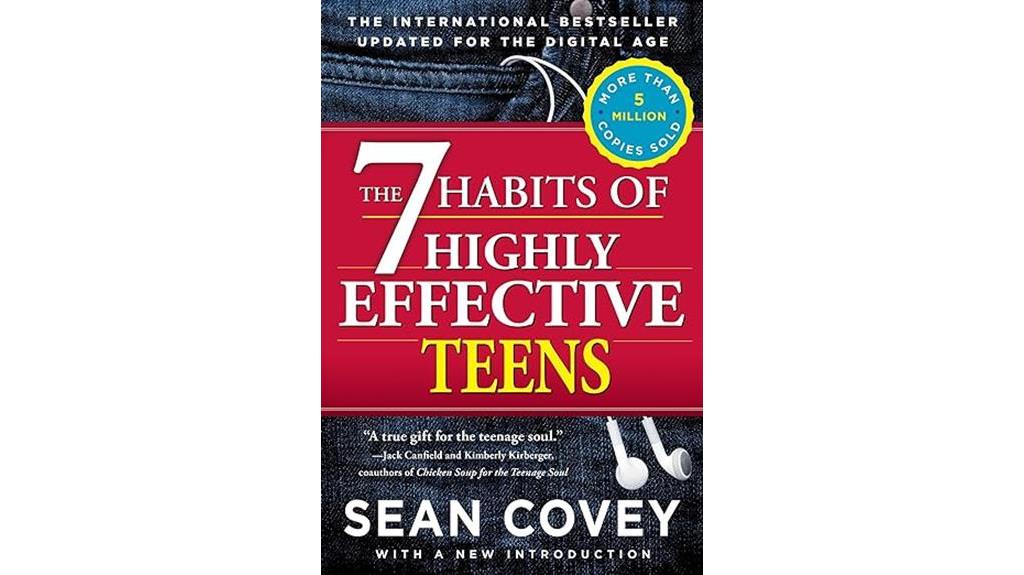
One essential resource for nurturing a harmonious family dynamic is exploring 'The 7 Habits of Highly Effective Teens.' This book offers practical advice and logical tips for teen success, making it impactful and life-changing for readers of all ages.
It's highly recommended for teenagers and young people, serving as a great starting point for personal development. With fantastic student takeaways in high school health classes and positive feedback from readers, this book is ideal for reluctant readers due to its creative approaches.
Whether introduced to teens at a young age or gifted to adolescents, 'The 7 Habits of Highly Effective Teens' is a compact and handy resource containing wonderful concepts for habit development, reflection on personal goals, and behavioral improvements.
Best For: Teens and adolescents seeking practical advice and tips for personal development in a compact and easy-to-understand format.
Pros:
- Highly educative and informative for young readers.
- Impactful and life-changing content suitable for teenagers.
- Great starting point for habit development and reflection on personal goals.
Cons:
- Some may find the book too small in size.
- May not appeal to readers looking for in-depth analysis or lengthy content.
- Limited scope for advanced personal development strategies.
Moms Moving On: Real Life Advice on Conquering Divorce, Co-Parenting Through Conflict, and Becoming Your Best Self

For moms managing divorce, co-parenting challenges, and seeking personal growth, 'Moms Moving On' offers invaluable real-life advice and support. This book provides practical tips, humor, and guidance for handling the complexities of divorce and co-parenting conflicts.
Readers praise the author, Michelle, for her relatable experiences and insightful advice, finding comfort and encouragement in her words. 'Moms Moving On' is highly recommended for those going through or considering divorce, as well as for individuals supporting loved ones on this journey.
The impact of this book is evident in the gratitude expressed by readers for its role in their healing process and its ability to address fears and offer hope. Michelle's writing style fosters a sense of connection and understanding, making 'Moms Moving On' a valuable companion for those facing divorce and co-parenting challenges.
Best For: Individuals navigating divorce, co-parenting challenges, and seeking personal growth.
Pros:
- Offers real-life advice and practical tips for handling divorce and co-parenting conflicts.
- Author's relatable experiences and insightful advice provide comfort and encouragement.
- Highly recommended for those going through or considering divorce, as well as for support systems.
Cons:
- May not address all specific individual situations.
- Some readers may find the content emotionally challenging.
- Limited focus on legal aspects of divorce and co-parenting.
Atomic Habits: An Easy & Proven Way to Build Good Habits & Break Bad Ones

Parents seeking practical strategies to improve family dynamics and foster a happier household will find 'Atomic Habits: An Easy & Proven Way to Build Good Habits & Break Bad Ones' an invaluable resource. In this book, author James Clear shares personal insights and strategies to help readers understand how habits impact life outcomes.
By focusing on making small changes that compound over time, individuals can achieve remarkable results. Clear emphasizes the importance of identity-based habits for lasting change and breaks down the behavior change process into cues, cravings, responses, and rewards.
Practical tips on building good habits include leveraging cues, creating attractive opportunities, making habits easy, and ensuring habits are satisfying. By implementing the principles outlined in 'Atomic Habits,' families can work towards creating a positive and fulfilling environment together.
Best For: Individuals seeking practical strategies to improve their habits and transform their life outcomes.
Pros:
- Provides actionable insights and strategies for building good habits and breaking bad ones.
- Emphasizes the importance of identity-based habits for lasting change.
- Offers practical tips on making habits attractive, easy, and satisfying for long-term success.
Cons:
- May require consistent effort and commitment to see significant results.
- Some strategies may not resonate with every individual's lifestyle or preferences.
- Implementing all the recommended habits simultaneously could be overwhelming for some people.
The Worlds Best Dad During and After Divorce: A Guide to Co-Parenting for Divorced Dads

Amidst the challenges of divorce, this guide equips fathers with practical strategies to navigate co-parenting complexities and maintain a positive presence in their children's lives. The book offers a thorough approach, addressing key aspects like communication, conflict resolution, and creating a balanced home environment.
It empowers divorced dads to handle the difficulties of divorce with grace and positivity, ensuring they continue to play influential and loving roles in their children's lives. Reader feedback appreciates the book's focus on fathers and its easy-to-understand tone, making it a valuable resource for dads seeking guidance during and after divorce.
While some readers noted gaps in handling unique situations, the book overall provides insightful perspectives on co-parenting, emphasizing the well-being of children. Personal experiences shared by readers highlight the book's role in maintaining focus and offering guidance on priorities during the divorce journey.
Recommendations suggest that individuals going through divorce can benefit from the book's practical ideas and suggestions, helping them stay focused on being the best dads they can be. Overall, the long-term impact of this guide is seen in its enduring value years after divorce, emphasizing the importance of maintaining a positive environment for children and prioritizing fatherhood.
Best For: Dads who are navigating the challenges of divorce and seeking practical guidance on co-parenting to maintain a positive relationship with their children.
Pros:
- Offers practical strategies and real-life advice for divorced dads.
- Addresses key aspects of co-parenting like communication and conflict resolution.
- Empowers fathers to handle divorce challenges with grace and positivity.
Cons:
- May have gaps in addressing unique or challenging circumstances.
- Some readers might find the information not comprehensive enough for all scenarios.
- Could benefit from more in-depth strategies for specific co-parenting situations.
How to Talk So Kids Will Listen & Listen So Kids Will Talk

When seeking practical strategies to enhance communication with children, exploring 'How to Talk So Kids Will Listen & Listen So Kids Will Talk' can greatly benefit one's parenting approach. This book offers clear and manageable advice on relevant parenting issues, encouraging reflection and mindset shifts in parenting styles.
Readers appreciate the helpful exercises and techniques provided, finding them easy to apply to different parenting situations. It includes specific words and phrases for parents to use in challenging moments, fostering effective communication with kids. Many readers highly recommend the book for its practical and encouraging approach to gentle parenting.
Despite some finding the book overly long, it's acknowledged for its practical tips and tricks for improving parent-child communication. Overall, 'How to Talk So Kids Will Listen & Listen So Kids Will Talk' is a valuable resource for parents looking to enhance their communication skills with children.
Best For: Parents seeking practical and effective strategies for improving communication with their children.
Pros:
- Clear and manageable advice on relevant parenting issues.
- Helpful exercises and techniques for different parenting situations.
- Encourages reflection and mindset shifts in parenting styles.
Cons:
- Some readers may find the book overly long and intimidating.
- Suggestions for a newer, shortened edition without unnecessary filler have been made.
- Despite some criticism, the book still offers practical tips and strategies for parent-child communication.
The Book You Wish Your Parents Had Read

For those seeking a candid and empathetic guide to parenthood that explores unconventional wisdom and emphasizes emotional connection, 'The Book You Wish Your Parents Had Read' by Philippa Perry is a valuable resource.
This book delves into the emotional aspects of parenting, prompting reflection on our upbringing and offering practical tools for enhancing communication and empathy within the family. Perry's approach, which views children as individuals with whom we've lifelong relationships, presents a fresh perspective compared to traditional parenting advice.
Readers have found this book instrumental in understanding their parenting styles, fostering healthier relationships, and making positive changes in their interactions with their children. Additionally, individuals who've faced emotional abuse or difficult parenting situations have found solace and guidance in 'The Book You Wish Your Parents Had Read', making it a recommended read for those seeking to nurture empathetic and loving relationships with their children.
Best For: Parents and caregivers seeking a compassionate and insightful guide to parenting that prioritizes emotional connection and empathy.
Pros:
- Encourages reflection on parenting styles and upbringing
- Offers practical tools for building communication and empathy within the family
- Provides a fresh perspective on viewing children as individuals with lifelong relationships
Cons:
- Contains sections that are opinion-based rather than solely research-based
- Some readers find a mix of insightful concepts and common knowledge, leading to varying degrees of factual information
- May not resonate with individuals looking for a strictly traditional parenting approach
Baby Knows Best: Raising a Confident and Resourceful Child, the RIE™ Way
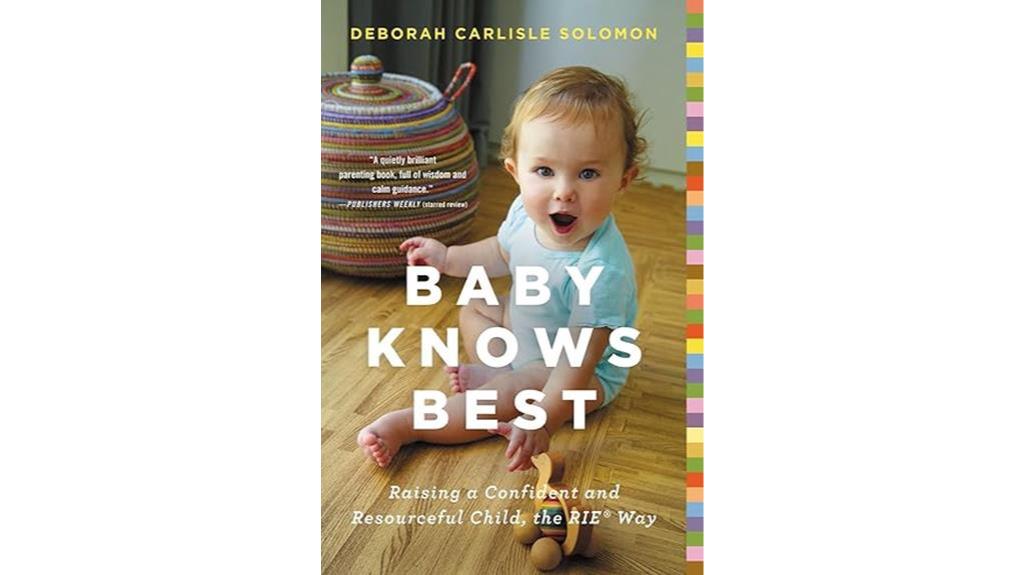
The book 'Baby Knows Best: Raising a Confident and Resourceful Child, the RIE™ Way' is a must-have for parents and professionals looking to adopt a child-led approach to parenting. This book emphasizes the RIE philosophy, which focuses on promoting children's independence and self-confidence.
By encouraging children to explore and problem-solve on their own, parents can support their natural development and foster a sense of autonomy. The RIE principles highlighted in the book include praising effort over achievement, acknowledging feelings, and providing a safe environment for self-directed play.
Implementing these strategies can lead to reduced parental stress, stronger parent-child connections, and improved communication skills. 'Baby Knows Best' offers practical guidance for respectful parenting, making it a valuable resource for anyone looking to enhance their parenting skills and create a happier family dynamic.
Best For: Parents and professionals seeking a child-led approach to parenting that emphasizes independence and self-confidence.
Pros:
- Practical guidance for implementing RIE philosophy in parenting.
- Positive impact on parent-child relationships and communication.
- Focus on fostering children's autonomy and problem-solving skills.
Cons:
- May require a shift in mindset for parents accustomed to more traditional parenting styles.
- Some concepts may be challenging to implement consistently.
- Not all strategies may resonate with every parent's parenting philosophy.
The Self-Driven Child: Giving Kids More Control Over Their Lives
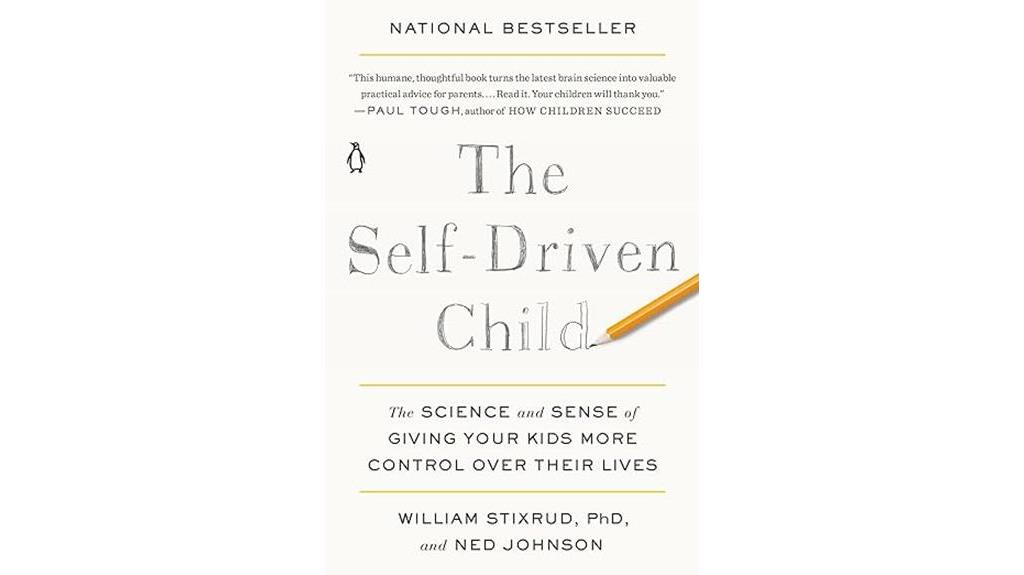
Parents seeking to empower their children and promote autonomy will find 'Parenting Books for a Happier Family' an invaluable resource for fostering resilience and internal motivation in their kids. In 'The Self-Driven Child: The Science and Sense of Giving Your Kids More Control Over Their Lives', authors William Stixrud and Ned Johnson emphasize the importance of creating a sense of control in children's lives to prepare them for the challenges they'll face.
The book advocates for a shift from a controlling to a consulting role as a parent, encouraging children to take more control over their decisions. By focusing on stress management and autonomy, parents can help their children develop resilience and internal motivation. Practical advice includes allowing children space to make decisions, promoting autonomy, competence, and relatedness, and offering empowering mental strategies for motivation and success.
The book's impact is evident in improved parent-child relationships and empowered children making confident decisions.
Best For: Parents, coaches, and teachers seeking to empower children to take control over their lives and improve resilience and internal motivation.
Pros:
- Encourages a shift from controlling to consulting parenting approach.
- Provides practical advice on stress management and autonomy.
- Offers empowering strategies for children's motivation and success.
Cons:
- Some parents may struggle to transition from a controlling to a consulting role.
- Requires consistent effort and patience to implement the book's principles effectively.
- May not fully address specific individual challenges faced by every child.
Teen Girls Survival Guide: Make Friends, Build Confidence, Avoid Peer Pressure, Overcome Challenges, Prepare for Future
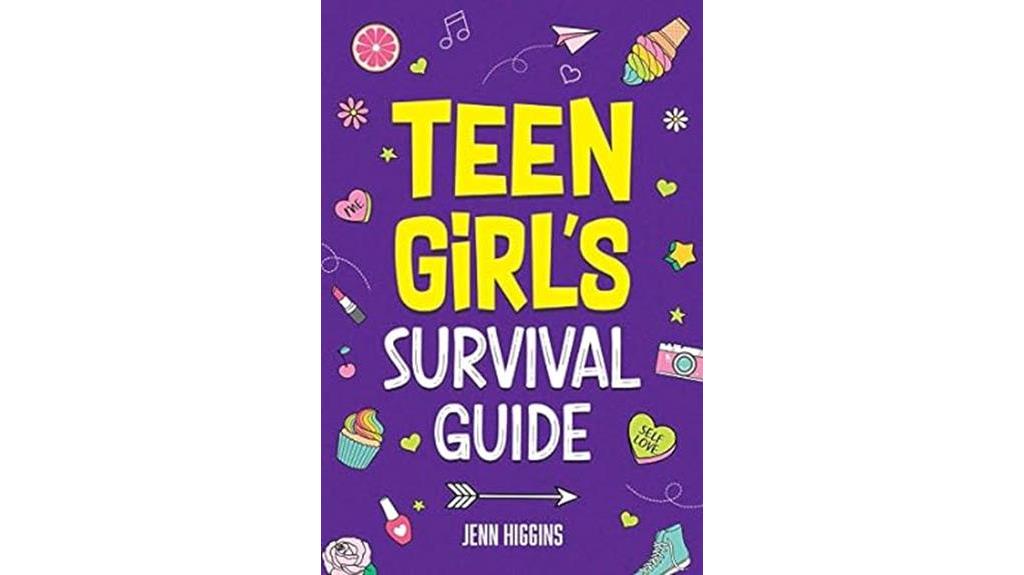
A must-have guide for helping teen girls navigate friendships, boost confidence, resist peer pressure, overcome challenges, and prepare for the future is the Teen Girls Survival Guide. This book has received positive feedback from both teenage girls and parents.
Teenagers have found it helpful in improving their communication skills and becoming more comfortable discussing important topics. Parents appreciate the book's direct approach and its ability to engage even reluctant readers.
The guide covers a wide range of subjects relevant to teenage girls, such as self-care in social settings and the importance of seeking help from trusted adults when needed.
With recommendations and positive reviews highlighting its effectiveness, the Teen Girls Survival Guide proves to be a valuable resource for young girls entering their teen years.
Best For: Parents looking for a comprehensive guide to help their teenage girls navigate friendships, boost confidence, resist peer pressure, overcome challenges, and prepare for the future.
Pros:
- Provides practical advice on communication and self-care for teenage girls.
- Engages both teenage girls and parents with its direct and informative approach.
- Covers a wide range of relevant topics for young girls transitioning into their teen years.
Cons:
- May not appeal to teenage girls who are resistant to self-help or guidance books.
- Some readers may find certain sections too mature or advanced for younger teenagers.
- Parents may need to encourage reluctant readers to engage with the content.
The Daily Dad: 366 Meditations on Parenting, Love, and Raising Great Kids
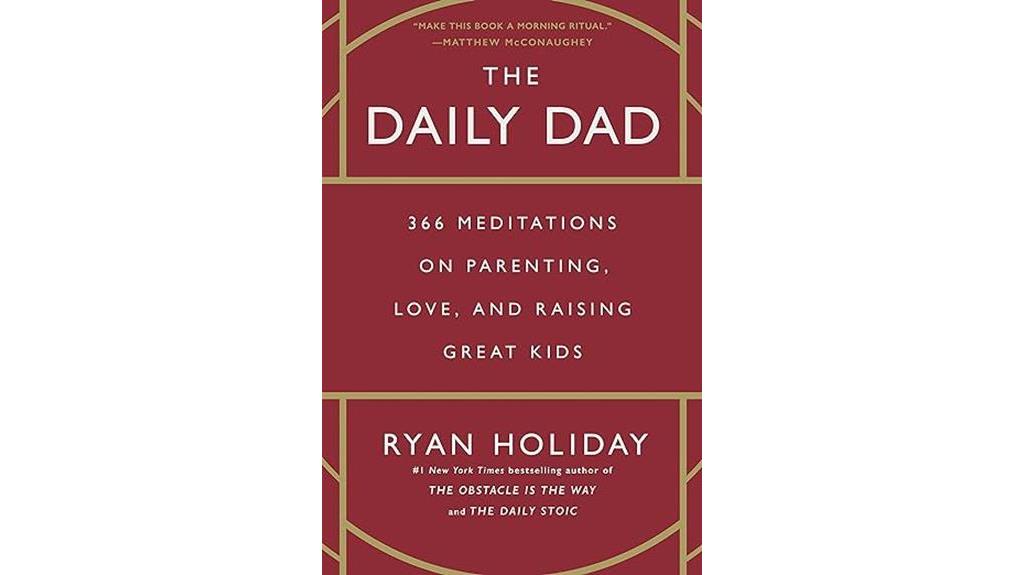
Ideal for dads seeking daily inspiration and practical parenting advice, 'The Daily Dad: 366 Meditations on Parenting, Love, and Raising Great Kids' offers valuable insights for managing fatherhood. With 366 concise meditations, this book provides bite-sized reflections perfect for busy dads like me. Drawing from personal experiences, timeless wisdom, and modern parenting research, each meditation touches on various aspects of fatherhood, fostering a sense of community and connection among fathers.
Readers recommend this book for its daily mindful moments, highlighting its impact on new parents and its resonance with readers. Key insights stress the importance of being present with children and prioritizing their needs. 'The Daily Dad' serves as a guide for parents and educators, enhancing parenting skills to create a positive impact on children's lives.
Best For: Busy dads seeking daily inspiration and practical parenting advice.
Pros:
- Offers daily mindful moments for fathers, moms, or caregivers.
- Provides valuable insights on parenting, love, and raising great kids.
- Fosters a sense of community and connection among fathers.
Cons:
- Some aspects may come across as intense or political to certain readers.
- Criticisms regarding comparisons to other works by the author.
- Feedback on missing features like a built-in bookmark.
1-2-3 Magic: Gentle 3-Step Child & Toddler Discipline for Calm, Effective, and Happy Parenting
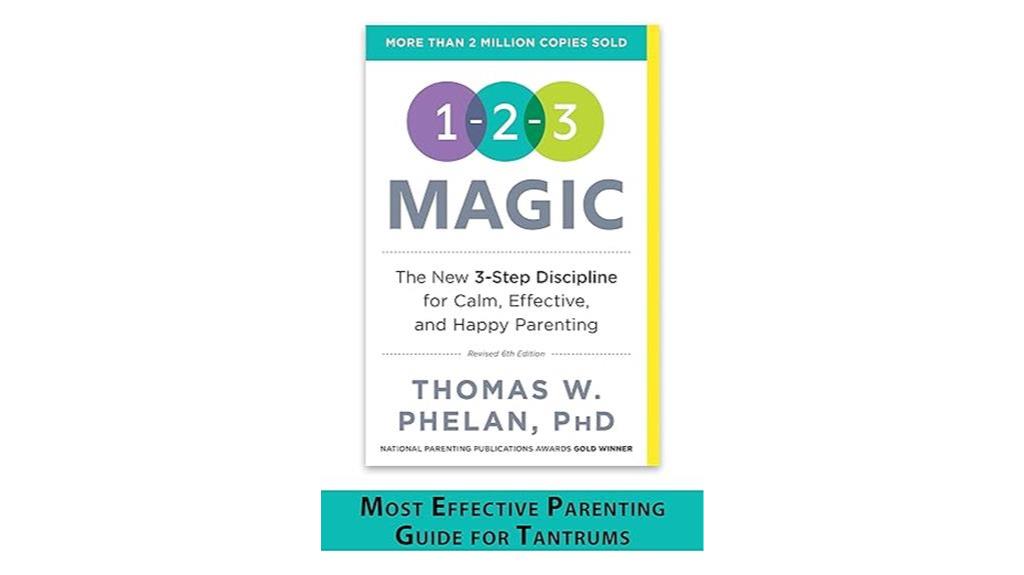
For those seeking a gentle and effective approach to child and toddler discipline, the 'Parenting Books for a Happier Family' offers the 1-2-3 Magic method as a calming and practical solution. This method introduces a 3-step process that emphasizes setting clear boundaries and using consequences to manage behavior.
Rather than engaging in lengthy discussions or escalating conflicts, parents can calmly implement the 1-2-3 Magic technique by giving a warning, counting to three, and applying a consequence if necessary. By focusing on consistency, simplicity, and maintaining composure, parents can create a more harmonious environment for their children.
The book provides specific guidance on using 'if/then' statements, ensuring that children understand the expectations and consequences of their actions. This method has received positive feedback from parents who've seen improvements in their children's behavior and a happier family dynamic.
Best For: Parents seeking a gentle and effective discipline approach for managing child and toddler behavior in a calm and practical manner.
Pros:
- Employs a simple 3-step process for setting boundaries and managing behavior.
- Emphasizes consistency and composure in parenting interactions.
- Offers specific techniques like 'if/then' statements for clearer communication with children.
Cons:
- May not be as effective for all children or in every situation.
- Requires parents to maintain consistency and patience in implementing the method.
- Some parents may find it challenging to adapt the technique to their child's individual needs.
Factors to Consider When Choosing Self Help Parenting Books

When selecting self-help parenting books, it's crucial to take into account factors such as the selection criteria, relevance to your parenting style, and practicality in application.
The impact these books may have on your parenting journey and learning from other readers' experiences can also play a significant role in making the right choice.
Selection Criteria
Consider the author's credentials and expertise in child psychology or parenting when selecting self-help parenting books for practical and effective guidance. It's important to confirm that the author has a solid background in the field to provide you with reliable advice.
Look for books that offer tangible strategies and techniques that you can easily apply in your day-to-day parenting challenges. Checking reviews and recommendations from other parents can give you insights into the book's effectiveness and relevance to your parenting style.
Assess the book's approach and philosophy to see if it resonates with your values and beliefs about parenting. Opt for books that specifically address the parenting issues you're currently facing, whether it's discipline, communication, or child development.
Additionally, seek recommendations from trusted sources such as parenting experts or therapists to guide your book selection process. By considering these criteria, you can choose self-help parenting books that best suit your needs and help you foster a happier family environment.
Relevance to Parenting
Examining whether the parenting book addresses specific challenges or concerns and aligns with one's parenting style and values is essential when selecting self-help parenting books. It's important to consider if the book tackles issues like communication struggles, effective discipline methods, or understanding child development stages that resonate with your parenting journey.
Additionally, choosing a book that reflects your parenting approach, whether it's gentle parenting, authoritative parenting, or a more structured method, can greatly impact its relevance to your family dynamics. Moreover, practical advice and actionable strategies that are easy to incorporate into your daily interactions with your children should be a key factor in your decision-making process.
Evaluating the author's credentials, expertise in parenting or psychology, and any professional endorsements can help gauge the book's credibility. Also, determining how the book caters to your child's age or developmental stage is important as strategies for parenting toddlers differ from those for adolescents.
Practicality and Application
When selecting a self-help parenting book that's practical and applicable, focus on seeking out strategies and techniques that can be easily implemented in real-life parenting scenarios.
Look for books that provide clear, step-by-step guidance on how to effectively apply the parenting techniques discussed.
Prioritize choosing a book that offers actionable advice with real-life examples to help you grasp how to incorporate these concepts into your daily interactions with your children.
Opt for books that include exercises or activities to practice the parenting skills introduced.
Consider the practicality of the strategies presented in the book and assess how seamlessly they can be integrated into your everyday life.
Evaluate whether the book offers customizable approaches that align with your family's unique needs and parenting style.
Check reviews or testimonials from other parents to gauge the effectiveness and practicality of the techniques provided in the book in real-world parenting situations.
Impact on Parenting
Parenting books play an essential role in shaping parenting styles and enhancing child-rearing practices by providing practical strategies and valuable insights. These books offer guidance on handling challenging situations, improving communication, and implementing effective discipline methods. By focusing on building strong parent-child relationships, fostering emotional intelligence, and promoting positive behavior in children, parenting books empower parents to address challenges confidently and create a nurturing home environment.
The impact of self-help parenting books extends beyond immediate solutions, encouraging personal growth, self-awareness, and the development of effective parenting techniques. They influence parenting styles by guiding boundaries, consequences, and communication with children, promoting consistency and a positive environment.
Reader Experiences
Reader experiences can serve as a valuable guide when exploring the vast landscape of self-help parenting books. By delving into personal testimonials and recommendations, one can gain profound insights into the practicality and impact of various parenting strategies. Understanding how readers have applied the advice from these books can offer a roadmap for others seeking resources that align with their parenting style. Feedback on specific techniques, advice, and overall effectiveness can help in determining if a book resonates with one's individual needs.
Real-world application stories shared by readers can provide a nuanced perspective on the transformative power of self-help parenting books in communication, boundary setting, and nurturing positive relationships with children. The anecdotes and insights shared by fellow readers often highlight the sense of community and support these books can offer in the rollercoaster journey of parenthood.
Author's Approach
When selecting self-help parenting books, it's important to consider the author's approach to parenting, including their focus on discipline, communication, emotional intelligence, or a combination of these aspects. Authors who provide practical strategies aligned with your parenting style and values can be particularly beneficial.
It's crucial to evaluate if the author's approach is evidence-based, drawing on research and psychology to support their recommendations. Additionally, take into account if the author's writing style is relatable, engaging, and easy to understand for practical application in real-life parenting situations.
Determining whether the author's approach addresses your specific parenting challenges and offers relevant solutions is key. Look for authors whose philosophy resonates with your own, as this alignment can enhance the book's impact.
Moreover, considering the author's qualifications, experience, credibility through reviews, and the provision of practical strategies and real-life examples are all important aspects to keep in mind when choosing a self-help parenting book.
Diversity in Perspectives
Exploring the diverse perspectives presented in self-help parenting books can offer valuable insights and alternative solutions to enhance one's approach to raising children. When selecting a parenting book, considering the range of viewpoints can provide a well-rounded understanding of different parenting styles and approaches.
Look for books that reflect various cultural, social, and familial backgrounds, offering a diverse set of experiences and insights. By prioritizing books that embrace inclusivity, parents can gain a broader understanding of effective parenting techniques. These diverse perspectives enrich the parenting journey by presenting fresh insights and alternative solutions to common issues.
Evaluating how authors address cultural differences, family dynamics, and individual needs ensures that the advice is applicable and inclusive. Seek out books that incorporate input from experts in child psychology and education, as well as real-life stories and practical tips from a variety of parents. Choosing a book that aligns with your parenting style and beliefs can provide a more thorough and enriching reading experience.
Frequently Asked Questions
How Can I Handle Sibling Rivalry Effectively in My Family?
When handling sibling rivalry in my family, I address conflicts promptly and calmly, acknowledging each child's feelings. Encouraging open communication helps them express emotions.
Implementing fair rules and consequences fosters a sense of equity and reduces tension. By fostering individual relationships with each child, I create a supportive environment that promotes understanding and empathy.
Consistent positive reinforcement and conflict resolution skills aid in managing and minimizing sibling rivalry effectively.
Are There Tips for Incorporating Mindfulness Into Daily Parenting Routines?
Incorporating mindfulness into daily parenting routines can enhance connection and reduce stress. Start with simple practices like deep breathing or mindful listening during interactions with your children.
Set aside dedicated time each day for mindfulness exercises, such as meditation or mindful walks. Consistency is key; aim for small, regular moments of mindfulness rather than sporadic efforts.
Over time, this can foster a calmer, more present parenting approach that benefits both you and your family.
What Are the Key Factors to Consider When Choosing Parenting Books?
When selecting parenting books, it's essential to take into account the author's expertise, the book's approach to parenting styles, and the specific challenges you're facing.
Look for practical advice that resonates with your values and beliefs. Remember, not all books will be a perfect fit; find one that speaks to you like a trusted friend giving advice.
Don't judge a book by its cover; explore the content to see if it aligns with your parenting goals and philosophies.
How Can I Navigate Co-Parenting Challenges After a Divorce?
Managing co-parenting challenges after a divorce requires open communication, setting boundaries, and prioritizing the well-being of the children. Establishing a detailed co-parenting plan can help handle expectations and reduce conflicts.
Flexibility and compromise are essential, as situations may evolve over time. Seeking support from a therapist or mediator can facilitate constructive discussions and problem-solving.
Is There Advice on Building Confidence and Resilience in Teen Girls?
Absolutely, building confidence and resilience in teen girls is essential. Encouraging open communication, fostering a supportive environment, and providing opportunities for personal growth can greatly enhance their self-esteem.
Empowering them to make decisions, learn from failures, and celebrate successes can boost their resilience. Engaging in activities that promote self-discovery and self-expression can also contribute to their overall confidence and emotional strength.
It's important to show them love, understanding, and encouragement throughout this journey.
Are Self-Help Parenting Books also Effective for Developing Emotional Intelligence in Children?
Many experts believe that the best parenting books emotional intelligence can be effective for developing emotional intelligence in children. These books provide valuable insights and strategies for parents to help their children understand and regulate their emotions, ultimately leading to healthier and more empathetic individuals.
Conclusion
To sum up, these self-help parenting books offer valuable insights and practical tips for creating a happier, more harmonious family life. By implementing the strategies outlined in these books, parents can improve their relationships with their children, develop effective discipline techniques, and cultivate a deeper understanding of themselves as parents.
Investing time in reading and applying the knowledge from these books can lead to a more peaceful and fulfilling parenting journey. So, why not give them a try and see the positive impact on your family dynamics?
Vetted
15 Best Natural Parenting Books Every Parent Should Read
Yearning for insightful guidance on natural parenting? Discover the top 15 books every parent should read for holistic approaches and valuable tips.

Navigating natural parenting involves discovering the **best books** on pregnancy, childbirth, and parenting styles. **’The Mama Natural Week-by-Week Guide’** gives amazing advice. **’Raising Good Humans’** offers mindful parenting tips. **’Natural Hospital Birth’** mixes natural and hospital births wonderfully. **’Your Child’s Best Face’** shares solid child health tips. **’The Nourishing Traditions Book’** explores traditional nutrition. **’Smart Medicine for a Healthier Child’** presents holistic remedies. **’Thriving with ADHD’** aids in natural ADHD management. Dive into these top natural parenting books and enjoy the journey!
Key Takeaways
- Practical tips for pregnancy, labor, and postpartum.
- Insightful strategies for handling parenting challenges.
- Empowerment for unmedicated hospital births.
- Solutions for child health and wellness.
- Traditional nutrition wisdom for holistic child-rearing.
The Mama Natural Week-by-Week Guide to Pregnancy and Childbirth
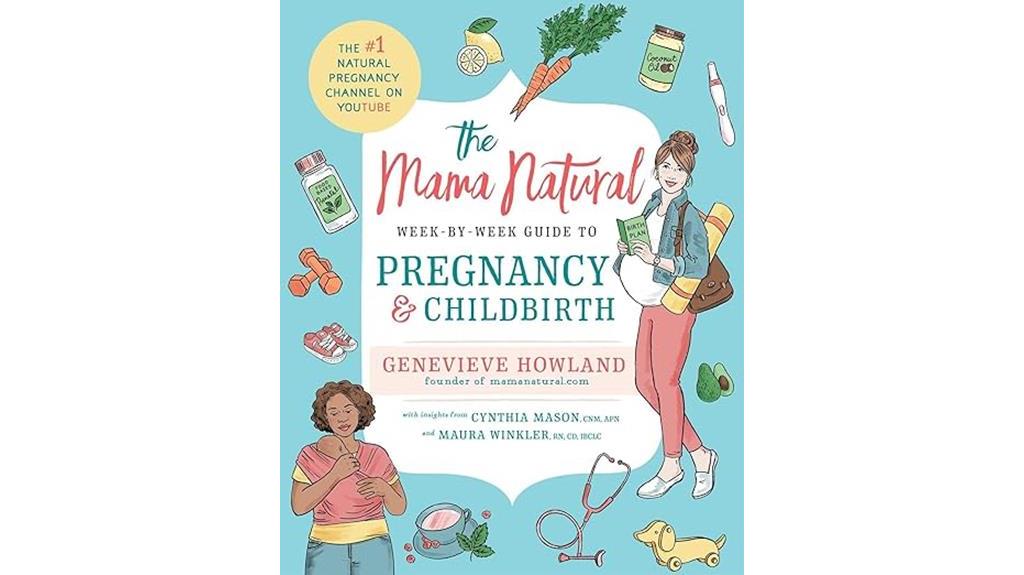
For those seeking a thorough and natural approach to pregnancy and childbirth, 'The Mama Natural Week-by-Week Guide' is an invaluable resource.
This detailed book breaks down essential information into easily digestible sections, covering everything from appointments and tests to exercises and healthy practices during pregnancy.
I appreciate the science-based research woven throughout the book, along with its beautiful illustrations that enhance understanding.
The week-by-week guide offers a unique perspective on pregnancy from a natural angle, making it a standout choice for expectant mothers.
Readers have shared positive experiences with the book, highlighting its practical tips, illustrations, and guidance on various aspects of pregnancy, labor, postpartum, and even pregnancy loss.
Whether you're a first-time mom or already experienced, this book emphasizes the importance of informed decision-making throughout your pregnancy journey.
Best For: Expectant mothers seeking a comprehensive and natural approach to pregnancy and childbirth.
Pros:
- Provides easily digestible information on various pregnancy-related topics.
- Offers practical tips, beautiful illustrations, and guidance for pregnancy, labor, and postpartum.
- Emphasizes informed decision-making and encourages a natural perspective on pregnancy.
Cons:
- Some readers have reported issues with printing errors and damaged copies.
- Minor concerns about the cost and appearance of the book.
- Quality feedback varies among readers.
Raising Good Humans: A Mindful Guide to Breaking the Cycle of Reactive Parenting
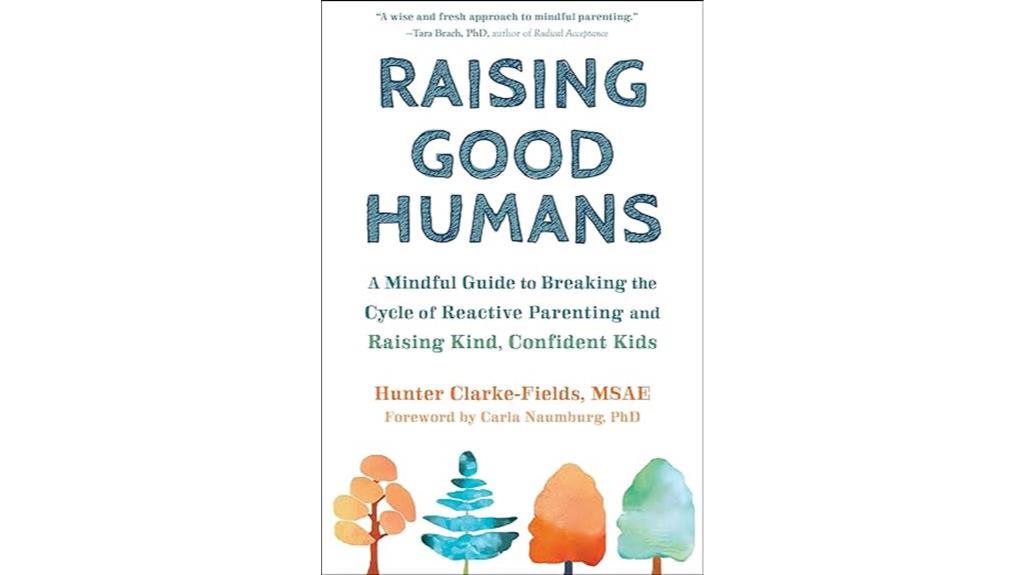
This insightful guide on breaking the cycle of reactive parenting is a valuable resource for parents seeking to enhance their approach to raising children mindfully. With positive reviews highlighting its helpfulness and engaging delivery, 'Raising Good Humans' has resonated with many readers, especially first-time parents.
The book's impact on parenting is evident, with readers mentioning a shift in their parenting style and the ability to navigate challenging moments with their children more effectively. While some readers faced challenges in unlearning past habits, the emphasis on self-work and mindfulness practices proved beneficial in their parenting journey.
Personal experiences shared by readers showcase the book's effectiveness in identifying triggers, promoting self-reflection, and ultimately, helping individuals become better parents. By emphasizing specific techniques like I language and mindfulness practices, this book equips parents with the tools to raise confident and emotionally resilient children.
Best For: Parents looking to break the cycle of reactive parenting and adopt a mindful approach to raising confident and resilient children.
Pros:
- Insightful and engaging delivery that resonates with readers.
- Effective strategies for handling difficult parenting moments.
- Emphasis on self-work and mindfulness practices for personal growth as a parent.
Cons:
- Some readers may find it challenging to unlearn past parenting habits.
- Initial difficulty in approaching mindfulness practices for a few readers.
- The emphasis on self-reflection and personal growth may require significant effort and commitment.
Natural Hospital Birth 2nd Edition: The Best of Both Worlds

With its practical guidance and real-life accounts, 'Natural Hospital Birth 2nd Edition: The Best of Both Worlds' is an invaluable resource for expectant mothers seeking to prepare for unmedicated hospital births.
The book not only offers information on natural birthing techniques but also provides insights into maneuvering the hospital environment while aiming for a medication-free delivery.
Readers appreciate the unbiased approach taken by the author, which allows all birthing mothers to benefit from the book's content, regardless of their birth plan.
By sharing personal experiences and testimonials, the book instills confidence in women, empowering them to advocate for their preferences during childbirth.
'Natural Hospital Birth 2nd Edition' stands out for its practical advice, helping mothers create birth plans aligned with their desires and make informed decisions throughout the labor process.
Best For: Expectant mothers seeking to prepare for unmedicated hospital births and looking for unbiased, practical guidance.
Pros:
- Valuable information for preparing for unmedicated hospital births
- Real-life accounts and personal experiences shared
- Empowers women to make informed decisions and advocate for their preferences during childbirth
Cons:
- May not cater to those planning medicated births
- Limited focus on alternative birthing options outside of hospitals
- Some readers may find the content repetitive if already well-versed in natural birthing techniques
Your Childs Best Face: How To Nurture Top Health & Natural Glow
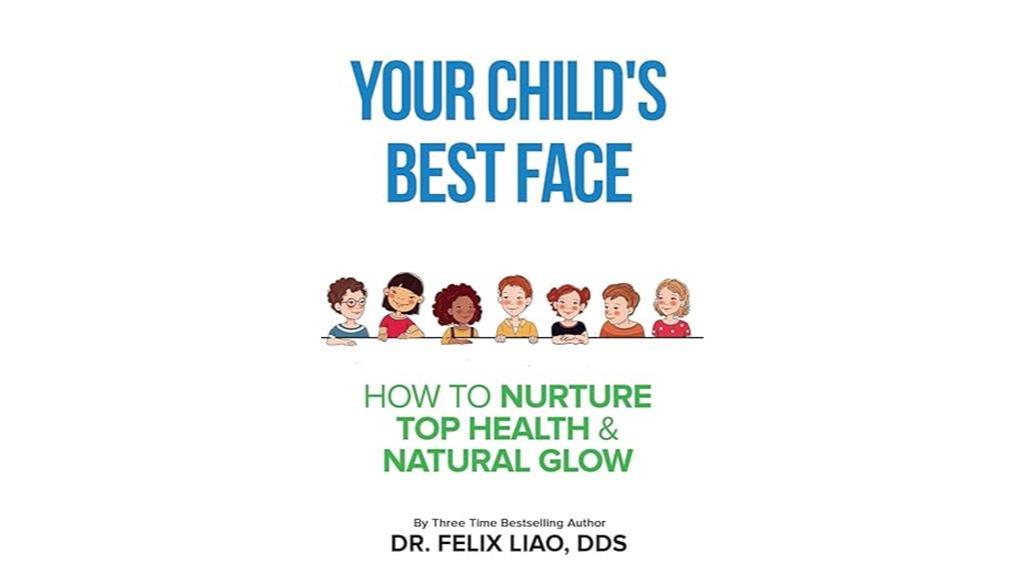
Exploring your child's top health and natural glow is made accessible through the insightful guidance provided in 'Your Child's Best Face,' a must-read for parents seeking to prioritize their child's overall well-being.
This book investigates the facial signs that can indicate underlying dental and systemic issues in children. It stresses the importance of early interventions to improve health outcomes.
In today's modern lifestyle, factors like diet and breathing habits can impact a child's facial development and overall health. 'Your Child's Best Face' offers practical solutions to reverse issues like mouth breathing and cavities, highlighting the link between facial symmetry and gut health.
With clear visuals and real-life cases, this book equips parents and dentists with the knowledge needed to address early signs of dental problems and promote their child's well-being.
Best For: Parents and dentists who want to understand the early signs of dental and systemic issues in children and learn how to improve their overall health outcomes.
Pros:
- Offers practical solutions to reverse issues like mouth breathing and cavities in children.
- Provides clear visuals and real-life cases to enhance understanding of facial development and health.
- Emphasizes the importance of early interventions for better physical and mental well-being in children.
Cons:
- Might require further professional consultation for specific individual cases.
- Some readers may find the technical dental terminology challenging to grasp.
- Not a quick-fix solution and requires consistent effort and follow-through.
The Nourishing Traditions Book of Baby & Child Care

For parents seeking a holistic approach to child-rearing rooted in traditional nutritional wisdom, 'The Nourishing Traditions Book of Baby & Child Care' offers an all-encompassing guide. This book explores the benefits of a traditional diet rich in grass-fed animal fats and proteins, contrasting it with conventional beliefs.
Drawing inspiration from Dr. Weston Price's research on traditional diets, it critiques mainstream dietary advice for babies and emphasizes the importance of animal fats in promoting healthy childbearing.
From pregnancy and nutrition guidelines to childbirth and newborn care advice, this book covers a wide array of topics. It also provides insights on infant care, feeding, child development, and nutrition, advocating for real foods and offering practical tips on parenting and toxin avoidance.
If you're looking to nurture your child's health through traditional nutritional practices, this book is a valuable resource.
Best For: Parents seeking a holistic and traditional approach to child-rearing through nutrition-focused practices.
Pros:
- Comprehensive coverage of traditional nutritional wisdom for raising healthy children.
- Emphasis on the importance of real foods and nutrients over conventional dietary advice.
- Practical tips and insights on pregnancy, childbirth, infant care, and child development.
Cons:
- May not align with mainstream dietary guidelines, potentially causing conflicting viewpoints.
- Emphasizes animal fats and proteins, which may not suit all dietary preferences.
- Some recommendations, such as homemade baby formulas, may require extra effort and preparation.
Mindful Birthing: Training the Mind, Body, and Heart for Childbirth and Beyond
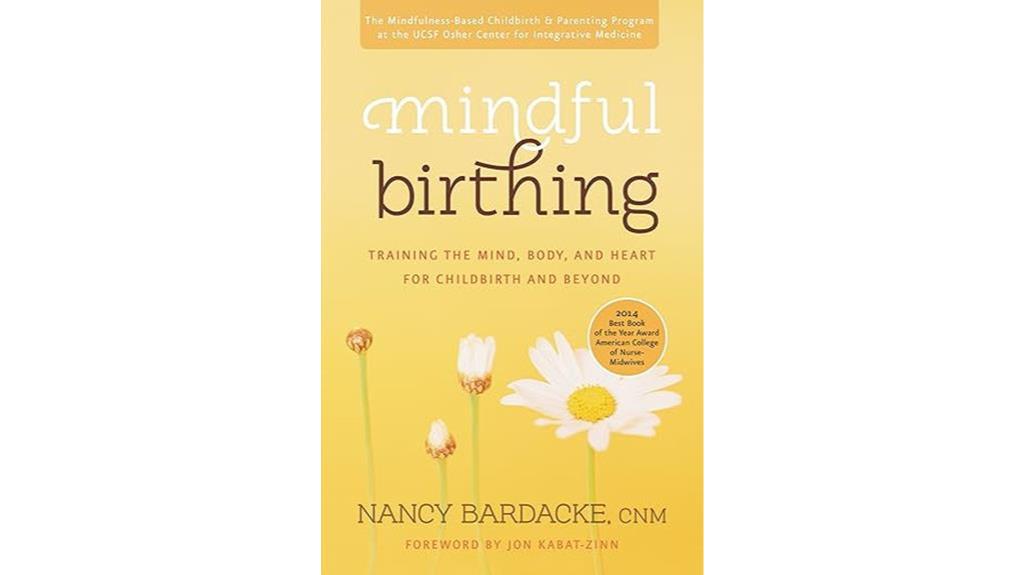
Readers seeking a thorough guide to incorporating mindfulness practices into their childbirth experience and beyond will find 'Mindful Birthing' a valuable resource.
This book has been praised for its ability to ease worries about childbirth and provide practical tools for labor and delivery. Many readers appreciated the holistic approach that 'Mindful Birthing' offers, finding the mindfulness techniques helpful in staying calm and in control during the birth process.
The non-judgmental stance of the book has also been well-received by individuals with different birth experiences. Highly recommended for expecting mothers and their partners, 'Mindful Birthing' has been found beneficial for various types of births, including medication-free births and VBACs.
Additionally, the book includes postpartum mindfulness techniques to help parents stay present and manage stress during the challenging early months of parenthood.
Best For: Expecting mothers and their partners seeking a mindful approach to childbirth and wanting practical tools for labor and delivery.
Pros:
- Provides practical tools for labor and delivery.
- Offers mindfulness techniques to stay calm and in control during childbirth.
- Includes postpartum mindfulness techniques for managing stress in the early months of parenthood.
Cons:
- May not resonate with individuals who prefer traditional childbirth approaches.
- Some readers may find the mindfulness techniques challenging to incorporate into their routine.
- The book's non-judgmental approach may not appeal to those seeking more prescriptive guidance.
The Natural Baby Sleep Solution

In addition to the practical approach offered by 'Natural Parenting Books for Parents' in improving infant sleep patterns through 'The Natural Baby Sleep Solution', this book has garnered positive testimonials. Parents have reported significant improvements in their baby's sleep routines, with some highlighting how the book helped a 10-month-old achieve uninterrupted sleep and reduced night awakenings.
The program's effectiveness was noticeable within just a few days of implementation, indicating quick results for sleep-deprived parents. Additionally, the book provides evidence-based information and valuable insights into recognizing signs of tiredness in babies, aiding in establishing better sleep habits.
While some feedback suggests a lack of tips for older infants, overall, the book's realistic expectations and user-friendly approach make it a valuable resource for parents seeking to enhance their baby's sleep quality.
Best For: Parents seeking evidence-based and practical guidance to improve their baby's sleep patterns efficiently.
Pros:
- Evidence-based information and clear insights for recognizing baby's tiredness cues.
- Quick results observed within a few days of implementing the program.
- Positive testimonials and recommendations from parents highlighting improved sleep quality.
Cons:
- Lack of practical tips specifically tailored for older babies.
- Realistic expectations may not fully address all sleep issues for every infant.
- Could benefit from more comprehensive guidance on sleep training techniques.
Nurture: A Modern Guide to Pregnancy, Birth, Early Motherhood
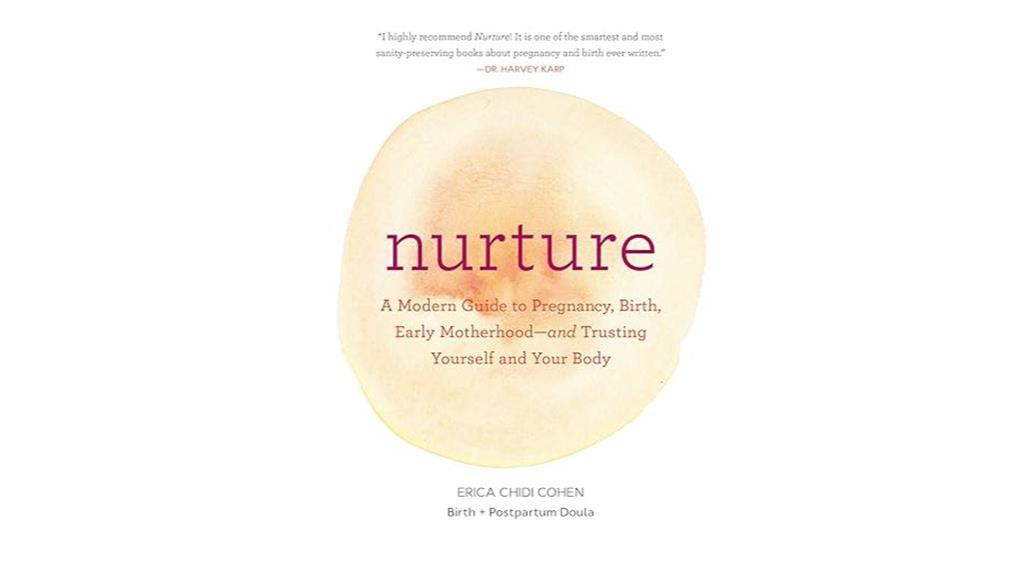
With its focus on holistic and natural birthing practices, 'Nurture: A Modern Guide to Pregnancy, Birth, Early Motherhood' is a valuable resource for expectant mothers seeking empowering and detailed information. The book encompasses various aspects of pregnancy, labor, birth, and postpartum care, offering thorough content ranging from baby development and body changes to breastfeeding and birth plans.
It provides practical advice on holistic birthing practices and includes month-by-month chapters addressing nutrition, exercises, and mental well-being. 'Nurture' also adds a personal touch by guiding readers through the emotional journey of pregnancy, encouraging trust in instincts, and offering relaxation techniques.
Despite some criticisms of basic or outdated information, the book remains educational, informative, and supportive, making it a beneficial read for expecting mothers looking for a blend of science and emotional support.
Best For: Expectant mothers who value holistic and natural birthing practices and seek a comprehensive guide for pregnancy, labor, and early motherhood.
Pros:
- Comprehensive coverage from pregnancy to postpartum, including baby development and birth plans.
- Personalized emotional support and encouragement for trusting instincts.
- Practical advice on holistic birthing practices and month-by-month guidance for well-being.
Cons:
- Some may find the information basic or outdated.
- Not universally applicable due to cultural differences.
- Mixed reviews on the scientific accuracy of the content.
Ina Mays Guide to Childbirth Updated With New Material
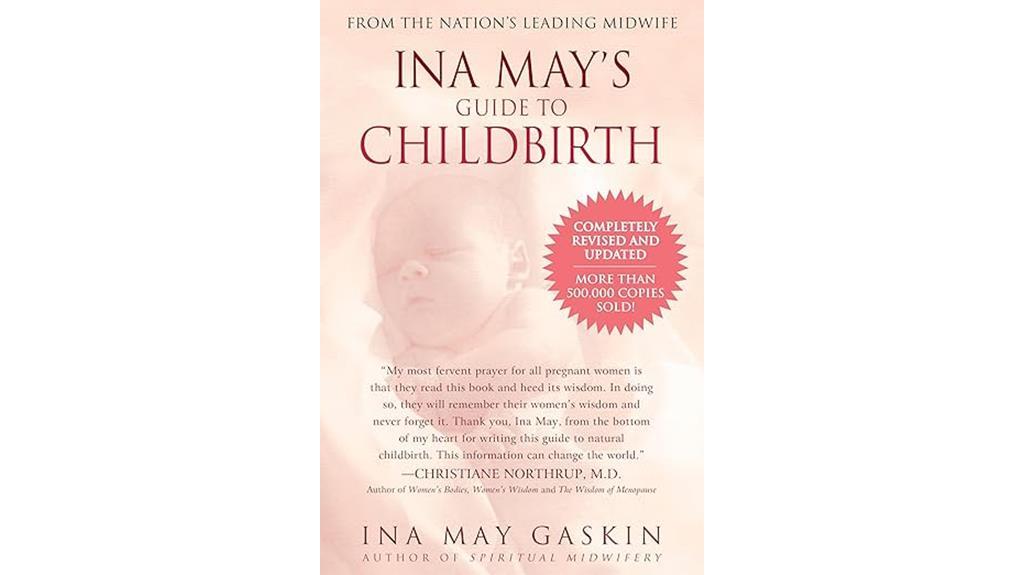
For parents seeking thorough guidance on natural childbirth experiences and empowerment, 'Ina May's Guide to Childbirth' with updated material is an invaluable resource. Ina May Gaskin, a renowned midwife, provides a wealth of knowledge and inspiration in this book.
The updated version includes new material that further enhances its relevance for expecting parents. Through empowering birth stories and practical advice, the book equips readers with confidence and understanding about the childbirth process.
It emphasizes the importance of informed decision-making and advocates for the natural birthing experience while also acknowledging the potential for medical interventions. Whether you're a first-time parent or looking to enhance your childbirth knowledge, 'Ina May's Guide to Childbirth' offers a detailed and insightful perspective that can positively impact your journey into parenthood.
Best For: Expecting parents seeking empowering birth stories, practical advice, and a deeper understanding of natural childbirth.
Pros:
- Provides empowering birth stories and practical advice.
- Equips readers with confidence and understanding about the childbirth process.
- Advocates for informed decision-making and natural birthing experiences.
Cons:
- May not fully address the complexity of medical interventions during childbirth.
- Some readers may find the emphasis on natural birth limiting in certain situations.
- Personal experiences shared may not resonate with all readers.
Breastfeeding Made Simple: Seven Natural Laws for Nursing Mothers
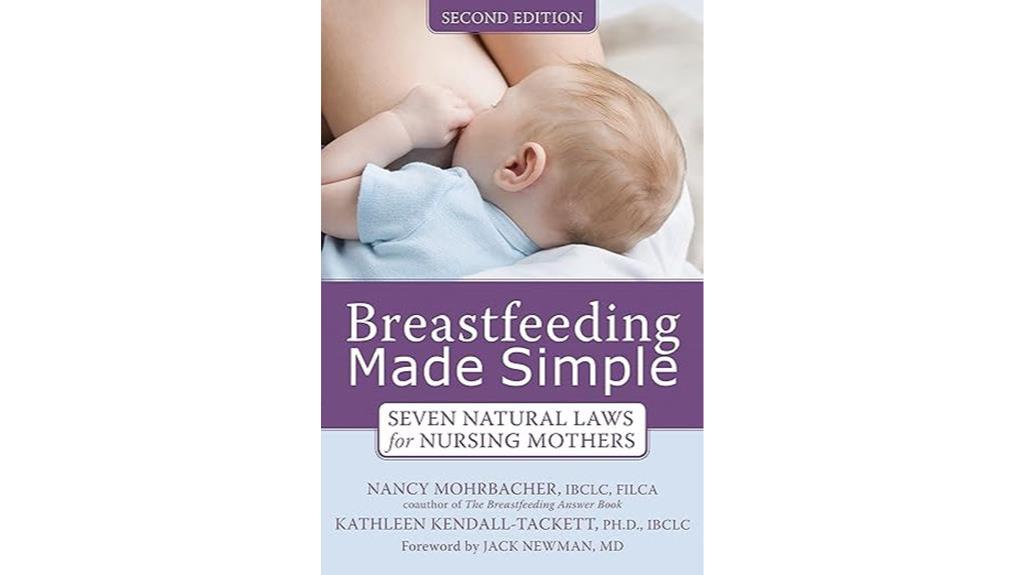
The book 'Breastfeeding Made Simple: Seven Natural Laws for Nursing Mothers' serves as an invaluable resource for first-time breastfeeding mothers looking for practical guidance and support. It offers a thorough guide to help mothers navigate the challenges and joys of breastfeeding.
Through personal experiences shared by other mothers, the book provides reassurance and practical tips on overcoming common breastfeeding obstacles. Reading this book before giving birth can better prepare mothers for the breastfeeding journey ahead.
It emphasizes the benefits of breastfeeding, both considering cost savings and the health advantages it offers to the baby. With explanations on milk supply, latch techniques, and addressing breastfeeding issues, this book equips mothers with the knowledge needed for successful nursing.
Best For: First-time breastfeeding mothers seeking practical guidance and support for overcoming common breastfeeding challenges and achieving successful nursing.
Pros:
- Comprehensive guide offering practical tips and insights from real experiences of other mothers.
- Emphasis on the benefits of breastfeeding and cost savings associated with it.
- Structured content covering essential topics like milk supply, latch techniques, and addressing breastfeeding issues.
Cons:
- May not cater to experienced breastfeeding mothers looking for more advanced techniques or information.
- Some readers may find the content repetitive if they have already gathered similar information from other sources.
- Limited focus on specific medical conditions or complications that may arise during breastfeeding.
The Best Homemade Baby Food on the Planet
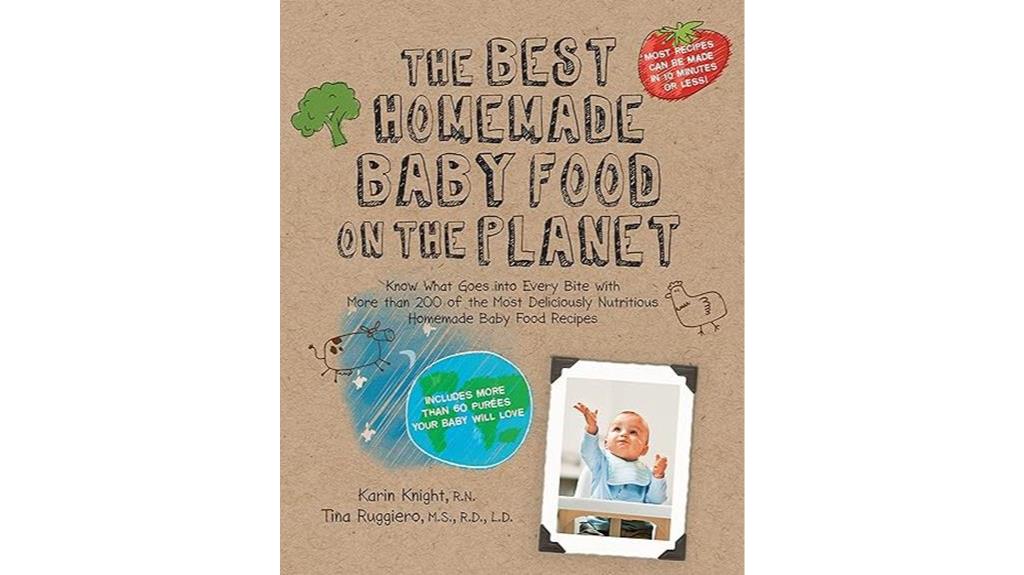
Containing a variety of creative and nutritious recipes, this book is a must-have for parents seeking to provide their babies and toddlers with wholesome homemade meals. With a clear layout and easy-to-follow instructions, it offers a range of healthy options that are quick to prepare, making mealtime a breeze for busy parents.
The incorporation of nutrient-dense foods and age-appropriate recipes guarantees that little ones receive the essential nutrition they need to thrive. Endorsed by a Registered Dietitian, this book emphasizes the significance of good nutrition for young children and provides valuable insights for parents guiding the world of homemade baby food.
From introducing foods based on age to freezer-friendly options and storage tips, this book equips parents with practical information to support their child's healthy eating journey.
Best For: Parents looking for a comprehensive guide to preparing creative and nutritious homemade meals for their babies and toddlers.
Pros:
- Well laid out with clear instructions.
- Variety of creative and healthy recipes.
- Includes practical information and tips for parents.
Cons:
- Some concerns raised about breastfeeding information.
- Desire for more diverse recipes beyond purees.
- Limited ideas catering to older babies.
Gentle Birth, Gentle Mothering: A Doctor's Guide to Natural Childbirth and Gentle Early Parenting Choices
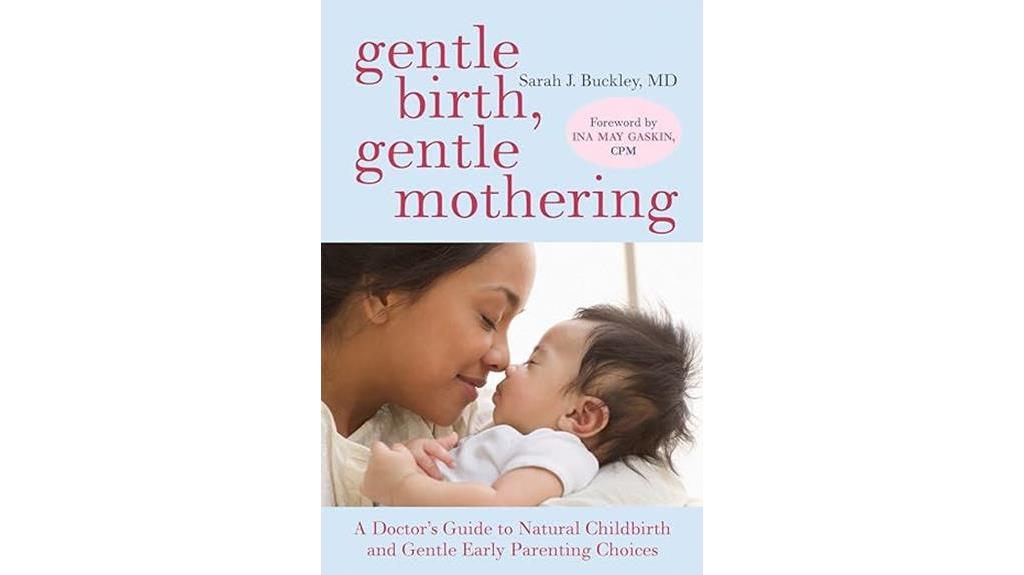
Highly recommended for those seeking evidence-based guidance on natural childbirth and early parenting choices, 'Gentle Birth, Gentle Mothering' empowers individuals to make informed decisions during their pregnancy journey.
Dr. Sarah Buckley's book advocates for undisturbed birth and gentle early parenting choices, presenting research against interventions like ultrasound and epidurals while emphasizing the benefits of skin-to-skin contact and breastfeeding.
The well-rounded mix of scientific facts and personal experiences encourages readers to explore birth options with an open mind. While some critics find the book too focused on natural birth, many appreciate the confidence it instills during labor.
Overall, 'Gentle Birth, Gentle Mothering' offers a thorough look at childbirth choices, helping readers navigate the journey with autonomy and informed decision-making.
Best For: Expectant mothers and individuals seeking evidence-based information and empowerment in natural childbirth and early parenting choices.
Pros:
- Research-based information advocating for undisturbed birth and gentle early parenting choices.
- Emphasis on benefits of skin-to-skin contact, co-sleeping, and breastfeeding supported by scientific evidence.
- Encourages informed decision-making in childbirth with a blend of personal experiences and research.
Cons:
- Some readers may find the book's emphasis on natural birth overwhelming or biased.
- Criticisms include a perceived negativity towards medical interventions rather than a balanced view.
- The book may trigger defensiveness or fear of medical interventions for some readers.
Smart Medicine for a Healthier Child

For parents seeking a thorough guide to childhood health remedies, 'Smart Medicine for a Healthier Child' is an invaluable resource. This book offers detailed information on a wide range of treatments for childhood maladies, providing parents with a thorough, effective, and helpful approach to managing their child's health.
It covers allopathic, herbal, homeopathic, and natural remedies in an easy-to-reference alphabetical layout. With a section dedicated to when to call the doctor, it offers valuable guidance in emergency situations. Users praise its extensive approach, practicality, and usefulness in addressing common and uncommon childhood illnesses.
Recommended by parents, birth assistants, and doulas, this book's versatility in providing nutritional, homeopathic, and herbal suggestions makes it a must-have for all parents looking to empower themselves in their child's health management.
Best For: Parents and caregivers looking for a comprehensive guide to managing their child's health through a variety of treatment options.
Pros:
- Provides detailed information on allopathic, herbal, homeopathic, and natural remedies.
- Alphabetical layout for easy reference.
- Includes guidance on when to seek medical help in emergency situations.
Cons:
- May be overwhelming for some users due to the extensive information provided.
- Could benefit from more specific dosage and administration guidelines.
- Limited focus on preventive measures for maintaining children's health.
Thriving with ADHD: A Guide to Naturally Reducing ADHD Symptoms in Your Child
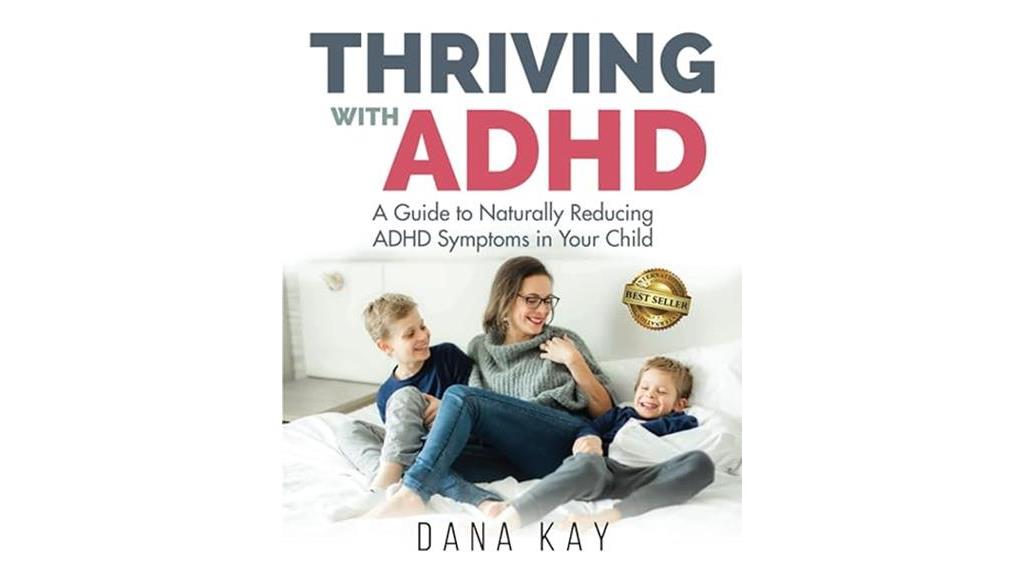
The guide 'Thriving with ADHD: A Guide to Naturally Reducing ADHD Symptoms in Your Child' is a valuable resource for parents seeking holistic strategies to support their child's well-being. Parents who've used the book found it practical, easy to follow, and filled with actionable steps. It serves as an excellent starting point for implementing natural approaches to address ADHD symptoms in children.
The book's holistic perspective, including advice on dietary and lifestyle changes, has been well-received by testimonials. Professionals, like integrative medicine physicians, have praised the impactful solutions presented in the book, emphasizing the importance of finding lasting remedies for children with challenging behaviors.
Readers appreciate the alternative treatment options beyond medication, finding hope in the possibility of their children thriving through healthy and natural methods. The book offers gratitude and inspiration, making it a recommended read for parents looking to understand and address ADHD symptoms from a holistic viewpoint.
Best For: Parents seeking natural and holistic strategies to help their children manage ADHD symptoms effectively.
Pros:
- Practical, easy-to-understand guide with actionable steps.
- Offers holistic approach including dietary and lifestyle recommendations.
- Provides hope and inspiration for parents looking for alternative treatments beyond medication.
Cons:
- May require significant time and effort to implement dietary and lifestyle changes.
- Individual results may vary in terms of symptom improvement.
- Some readers may prefer more in-depth scientific explanations on the strategies suggested.
The Simplest Pregnancy Book in the World
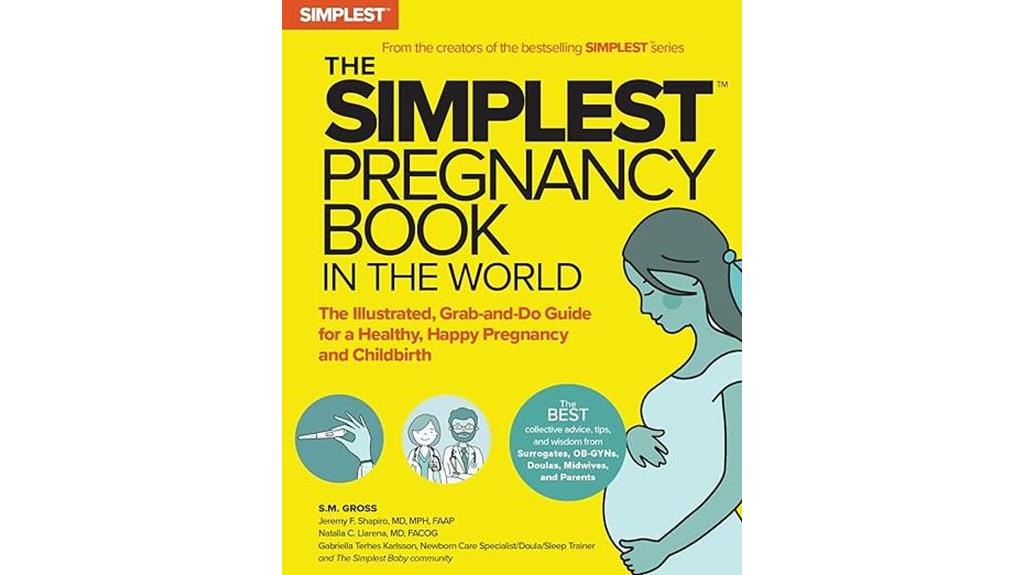
With its practical and informative approach, 'The Simplest Pregnancy Book in the World' is a must-have for expectant moms seeking a straightforward guide to pregnancy and childbirth. This book has garnered positive reviews for its ability to ease fears and provide answers to common questions expectant mothers may have.
It covers a wide range of topics related to pregnancy and childbirth, helping readers prepare for labor and find suitable resources. The information presented is detailed yet concise, making it easy to traverse and understand.
Whether you're a first-time mom or experienced in parenthood, this book offers honest facts, helpful hacks, and practical tips for each trimester and post-birth care. Written in a simple and accessible manner, 'The Simplest Pregnancy Book in the World' is organized for easy reading, making it a valuable resource for journeying through the experience of pregnancy and parenthood.
Best For: First-time and experienced moms looking for a practical and informative guide to pregnancy and childbirth.
Pros:
- Practical, simple, and informative approach.
- Eases fears and answers common questions for expectant moms.
- Useful information presented in a detailed yet concise manner.
Cons:
- May lack in-depth coverage on certain specific topics.
- Some readers may prefer more visual aids or illustrations.
- Limited focus on postpartum mental health and emotional well-being.
Factors to Consider When Choosing Natural Parenting Books

When selecting natural parenting books, it's crucial to take into account criteria such as the author's credibility, the relevance of the content to your parenting style, and the inclusion of practical tips.
Ensuring the book balances modern practices with natural approaches can provide a well-rounded perspective on parenting techniques.
Criteria for Selecting Books
Consideration of the author's credentials and expertise in natural parenting is essential when selecting books on the subject. Making sure that the author has a solid background in natural parenting practices can help guarantee that the information provided is reliable and trustworthy.
Look for books that not only offer practical tips but also present evidence-based research and actionable advice for implementing natural parenting methods effectively. It's beneficial to choose a book that covers a wide range of topics related to pregnancy, childbirth, breastfeeding, and child development to get a thorough understanding of natural parenting.
Additionally, prioritize books that align with your parenting philosophy and values to ensure that the content resonates with your approach. Selecting a book that provides guidance on incorporating natural remedies, holistic practices, and healthy lifestyle choices for raising children can further support your natural parenting journey.
Author Credibility Importance
To ensure the reliability and trustworthiness of information in natural parenting books, it's essential to carefully assess the credibility of the authors behind the content.
When selecting a natural parenting book, consider authors with backgrounds in fields like pediatrics, child psychology, nutrition, or holistic health. Authors who are experienced practitioners, researchers, or educators in natural parenting can offer valuable insights and evidence-based advice.
Look for authors with a strong reputation in the natural parenting community or those who've published well-regarded works in the field. Checking for endorsements, reviews, or recommendations from reputable sources or experts in natural parenting can help gauge the author's credibility.
Authors with relevant qualifications, experience, and expertise in natural parenting increase the credibility of the content they provide. Additionally, authors who've conducted research, published studies, or have a background in child development are more likely to offer valuable insights in their books.
Consider the author's reputation and track record in the natural parenting space to align their perspectives with your values and beliefs.
Relevance to Parenting Style
Understanding how a natural parenting book resonates with my personal parenting philosophy and values is vital when selecting reading material for guidance and insights. It's essential to assess whether the book aligns with my parenting style, whether it's attachment parenting, gentle parenting, or holistic parenting.
By choosing a book that mirrors my approach, I can better integrate the strategies and techniques suggested within its pages. Additionally, evaluating if the book addresses specific challenges I face in my parenting journey is paramount. It's important to make sure that the book's natural parenting approach is evidence-based and backed by research, providing a solid foundation for its recommendations.
Selecting a book that offers practical advice and strategies that can be easily implemented into my daily routines is advantageous. By focusing on my parenting style, concerns, and interests, I can find a natural parenting book that resonates with me and provides valuable insights tailored to my individual needs.
Inclusion of Practical Tips
How can natural parenting books enrich my journey as a parent by providing practical tips for implementing holistic parenting practices effectively and efficiently?
Natural parenting books offer valuable insights into incorporating holistic parenting methods into daily routines. When choosing a book, look for practical tips on breastfeeding, babywearing, natural remedies, and more. Seek step-by-step guidance on creating natural birth plans, making baby food, and practicing mindfulness techniques.
Opt for books with hands-on activities to help you apply these methods in real-life situations. It's beneficial to have real-life examples and case studies to understand how these practices work in different scenarios. Additionally, books should provide resources and references for further exploration. Practical advice supported by scientific evidence ensures safety and effectiveness.
Choose books with manageable tips that suit your busy lifestyle. By incorporating practical tips from natural parenting books, you can navigate the challenges of holistic parenting with confidence and ease.
Balancing Modern Practices
When selecting natural parenting books, it's important to examine how they strike a balance between modern medical practices and traditional or holistic approaches. Look for books that offer a well-rounded view of modern parenting challenges while advocating for natural solutions.
Consider how the books address the integration of modern technology and natural parenting methods. Evaluate if the books provide evidence-based information on the effectiveness of natural parenting techniques in a modern context. Assess whether the books offer practical tips and strategies for incorporating natural parenting principles into a modern lifestyle.
Also, consider how the book balances modern parenting practices with natural and holistic approaches. Look for information on integrating traditional wisdom with contemporary research and recommendations. Evaluate the book's approach to incorporating modern tools and technologies while staying true to natural parenting principles.
Check if the book addresses the challenges of navigating modern lifestyles while prioritizing natural and sustainable parenting choices. Make sure the book offers practical tips and strategies for implementing natural parenting in a modern world.
Research-Backed Information
To make informed choices when selecting natural parenting books, consider prioritizing those that present research-backed information supported by scientific studies and evidence. Look for books that cite reputable sources and studies to guarantee the information provided is reliable and accurate.
It's crucial to choose books that offer a balanced view of natural parenting methods, incorporating both traditional wisdom and modern research findings. Books that emphasize evidence-based practices and recommendations for raising children in a healthy and holistic manner can provide valuable insights.
Additionally, seek out books that emphasize the importance of informed decision-making based on scientific evidence when it comes to natural parenting choices. By selecting books that provide evidence-based information supported by scientific research on natural parenting practices, you can equip yourself with the knowledge needed to make informed decisions for your child's well-being.
Prioritizing research-backed information can help you navigate the vast array of natural parenting advice available and choose strategies based on proven research.
User-Friendly Layout
Consider selecting natural parenting books that feature a user-friendly layout, incorporating clear headings, bullet points, and diagrams to enhance comprehension and ease of navigation. A well-organized book can make it easier to find information quickly and follow the content effectively.
Look for books that break down complex concepts into manageable sections, offering a structured and organized reading experience. Check for clear headings and subheadings that guide you through the content seamlessly.
Opt for books with a consistent format, using bullet points, lists, and summaries to aid in understanding and retention of information. Additionally, a visually appealing layout with illustrations, charts, and diagrams can enhance your comprehension of challenging topics.
Make sure the book includes a table of contents, index, and glossary for easy access to specific topics and terms. By choosing a natural parenting book with a user-friendly layout, you can enhance your reading experience and benefit from a well-structured resource.
Engaging Visual Elements
Exploring natural parenting books involves seeking out those that incorporate engaging visual elements to enhance understanding and retention of information. Visual aids like illustrations, diagrams, and charts play an important role in simplifying complex concepts, making them more accessible and enjoyable to learn.
For instance, illustrations depicting parenting techniques or exercises can clarify instructions, aiding in easier implementation. Additionally, visual representations of data and statistics help readers grasp key points effectively, enabling them to make informed decisions. Books with visually appealing layouts and designs not only enhance the reading experience but also keep readers engaged throughout the content.
Colorful and well-designed graphics not only make the information more appealing but also aid in retention. By breaking up text-heavy sections and incorporating photographs and infographics, natural parenting books cater to various learning styles, ensuring active engagement with the content. Essentially, engaging visual elements are essential in making natural parenting books informative, interactive, and visually stimulating.
Frequently Asked Questions
Can Natural Parenting Books Help With ADHD Symptoms in Children?
Yes, natural parenting books can provide strategies and insights on supporting children with ADHD symptoms. These books often offer holistic approaches, such as nutrition, mindfulness, and positive discipline techniques, which can complement traditional treatment methods.
Understanding how lifestyle factors can impact ADHD symptoms may help parents better navigate their child's challenges. While not a replacement for professional medical advice, these resources can be valuable tools in managing ADHD in children.
How Can I Choose the Best Natural Parenting Book for My Family?
To choose the best natural parenting book for my family, I consider our specific needs and values. Researching authors and their expertise in natural parenting is essential. Reading reviews from other parents can provide valuable insights.
I also look for books that align with my parenting style and goals. Checking for up-to-date information and practical advice guarantees relevance.
Ultimately, selecting a book that resonates with me personally is key to finding the best fit for my family.
What Are Some Key Factors to Consider When Selecting a Natural Parenting Book?
When choosing a natural parenting book, consider the author's credentials, ensuring they have expertise in child development.
Look for a book that aligns with your parenting philosophy and addresses your specific concerns.
Check reviews for insights on readability and practicality.
Assess the book's organization and layout to see if it suits your learning style.
Lastly, opt for updated editions to access the latest research and recommendations.
These factors can guide you to the right natural parenting book for your family.
Do These Books Address Common Breastfeeding Challenges for New Mothers?
When it comes to addressing common breastfeeding challenges for new mothers, natural parenting books often provide valuable insights and practical tips.
These books typically cover topics such as latching issues, low milk supply, engorgement, and mastitis. They offer guidance on proper breastfeeding techniques, troubleshooting problems, and seeking professional support when needed.
Are There Specific Tips for Promoting Natural Sleep Solutions for Babies?
When it comes to promoting natural sleep solutions for babies, establishing a consistent bedtime routine can work wonders.
Incorporating soothing activities like gentle massages or lullabies can signal to your little one that it's time to wind down.
Additionally, creating a calm sleep environment with minimal distractions can help encourage peaceful slumber.
Are Natural Parenting Techniques Suitable for Raising Tweens?
Many parents find it challenging to navigate the tween years. Fortunately, there are numerous best parenting books for tweens that offer valuable insights into natural parenting techniques. By incorporating gentle discipline and open communication, parents can create a supportive and nurturing environment for their tweens to thrive.
Conclusion
As you explore the world of natural parenting, let these books be your guiding light, illuminating the path with wisdom and knowledge.
With each exploration of the page, you'll find yourself empowered to nurture your child with love and intention, creating a bond that will last a lifetime.
So immerse yourself in these insightful reads, and watch as your journey as a parent blossoms into something truly beautiful and fulfilling.
Vetted
15 Best Mindful Parenting Books Every Parent Should Read
Kickstart your mindful parenting journey with these 15 essential books, offering insights and strategies to navigate the challenges of raising children with mindfulness.

**Exploring** mindful parenting books really **boosts** your parenting journey. Must-reads include **”Raising Good Humans”**, which helps you ditch reactive habits, **”Mindful Birthing”**, offering a whole mind-body birth method, and **”Being at Your Best When Your Kids Are at Their Worst”**, packed with practical compassion tips. **”Parenting at Your Best”** shares amazing insights. When choosing from the many options, consider content and how engaging they are. These books give priceless strategies to grow a mindful parenting style.
Key Takeaways
- "Raising Good Humans" offers practical advice for mindful parenting.
- "Mindful Discipline" emphasizes emotional intelligence in parenting.
- "Mindful Birthing" focuses on training the mind, body, and heart.
- "Growing Up Mindful" provides insights on raising mindful children.
- "Parenting from the Inside Out" explores self-understanding in raising thriving kids.
Raising Good Humans: A Mindful Guide to Breaking the Cycle of Reactive Parenting
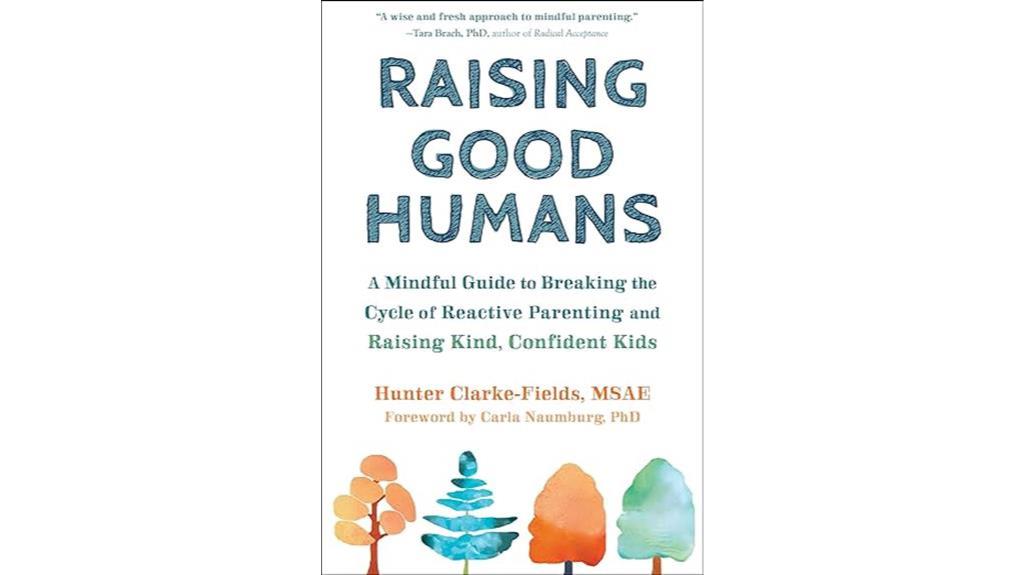
For those seeking insightful guidance on breaking the cycle of reactive parenting and fostering mindful relationships with their children, 'Raising Good Humans' is an invaluable resource. This book has received positive reviews and recommendations for its engaging and helpful approach, making it a must-read for all parents, especially first-timers.
Readers highlight the importance of self-work and patience in parenting, showing how this book can positively impact one's parenting style. Many readers mention how the strategies provided in 'Raising Good Humans' have helped them navigate challenging moments with their children, ultimately leading to more confident kids.
Despite some challenges in unlearning past parenting habits, the emphasis on self-work and mindfulness practices in this book has proven to be transformative for many.
Best For: Parents looking to break the cycle of reactive parenting and develop mindful relationships with their children.
Pros:
- Insightful guidance for improving parenting skills.
- Valuable strategies for handling difficult moments with children.
- Emphasis on self-work and mindfulness practices for personal growth.
Cons:
- Some readers may find it challenging to unlearn past parenting habits.
- Initial difficulty in approaching mindfulness practices for a few readers.
- Requires consistent effort and self-reflection, which may be demanding for some.
Mindful Parenting for ADHD Guide
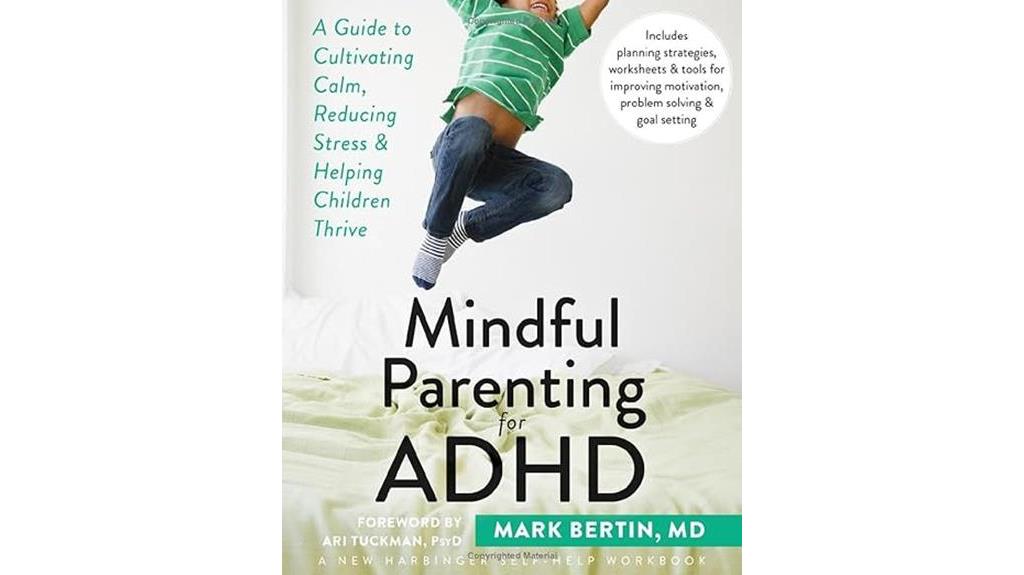
The 'Mindful Parenting for ADHD' guide is an invaluable resource recommended for parents managing the challenges of raising children with ADHD. This book offers a unique and practical approach, providing insightful advice alongside worksheets and action plans.
It covers essential topics such as organization techniques, homework plans, and academic support, emphasizing the importance of aiding children with ADHD in their learning journey. Medical professionals regard it as groundbreaking, contributing to a better understanding of ADHD as a developmental brain delay.
The book also focuses on practical guidance, offering easy-to-follow suggestions for effective parenting skills and communication strategies. By integrating mindfulness practices, it helps parents become more mindful individuals, fostering calm, improved focus, self-regulation, and compassion in handling the complexities of raising children with ADHD.
Best For: Parents of children with ADHD seeking practical guidance and support in mindful parenting techniques.
Pros:
- Comprehensive advice and worksheets for organization and academic support.
- Integration of mindfulness practices for improved focus and compassion.
- Easy-to-follow suggestions for effective parenting skills and communication strategies.
Cons:
- May require consistent practice and dedication to see significant results.
- Not all strategies may work for every child with ADHD.
- Additional support or resources may be needed for more complex cases.
Mindful Birthing: Training the Mind, Body, and Heart for Childbirth and Beyond
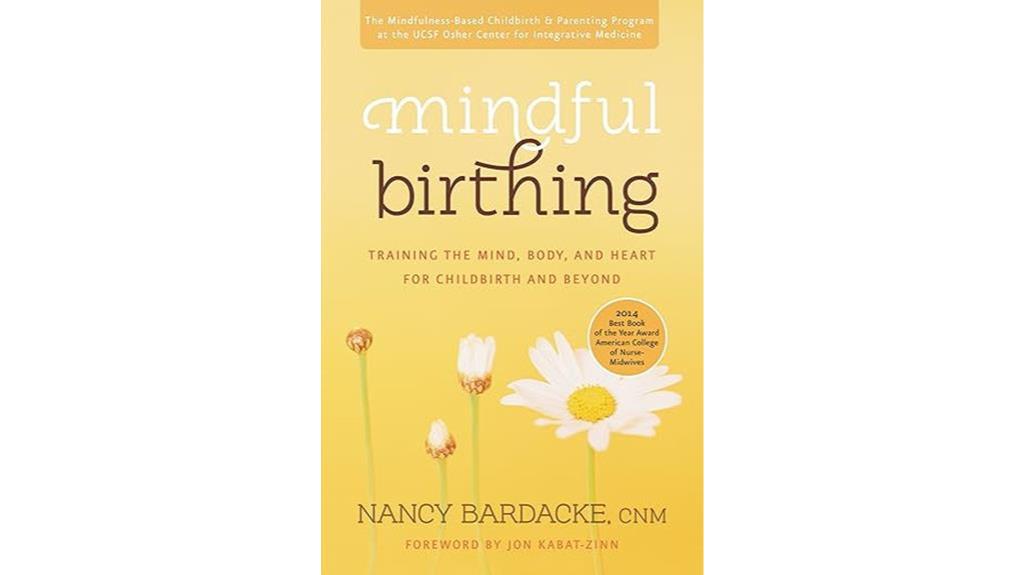
Ideal for expecting parents seeking a holistic approach to childbirth and mindfulness techniques, 'Mindful Birthing' provides valuable tools for managing the birthing experience and beyond. This book has been praised for easing worries surrounding childbirth and offering practical strategies for labor and delivery.
Readers appreciated the non-judgmental approach and found the mindfulness techniques instrumental in staying calm and composed during birth. 'Mindful Birthing' comes highly recommended for expecting mothers and their partners, with many highlighting its effectiveness for various types of births, including medication-free deliveries and VBACs.
Additionally, the book includes guidance on postpartum mindfulness, aiding readers in staying present and managing stress during the initial months of parenting. With positive feedback on its impact on birth experiences, 'Mindful Birthing' is a valuable resource for those seeking a mindful approach to childbirth and beyond.
Best For: Expecting parents looking for a comprehensive guide to mindfulness techniques and holistic approaches to childbirth and parenting.
Pros:
- Offers practical tools and strategies for managing the birthing experience.
- Non-judgmental approach appreciated by readers with different birth experiences.
- Includes guidance on postpartum mindfulness to assist in staying present and reducing stress during early parenting.
Cons:
- Some readers may find the mindfulness techniques challenging to implement consistently.
- May not cater to individuals who prefer a more traditional, medical-focused approach to childbirth.
- Limited focus on specific medical interventions or complications that may arise during childbirth.
Mindful Parenting for ADHD Children
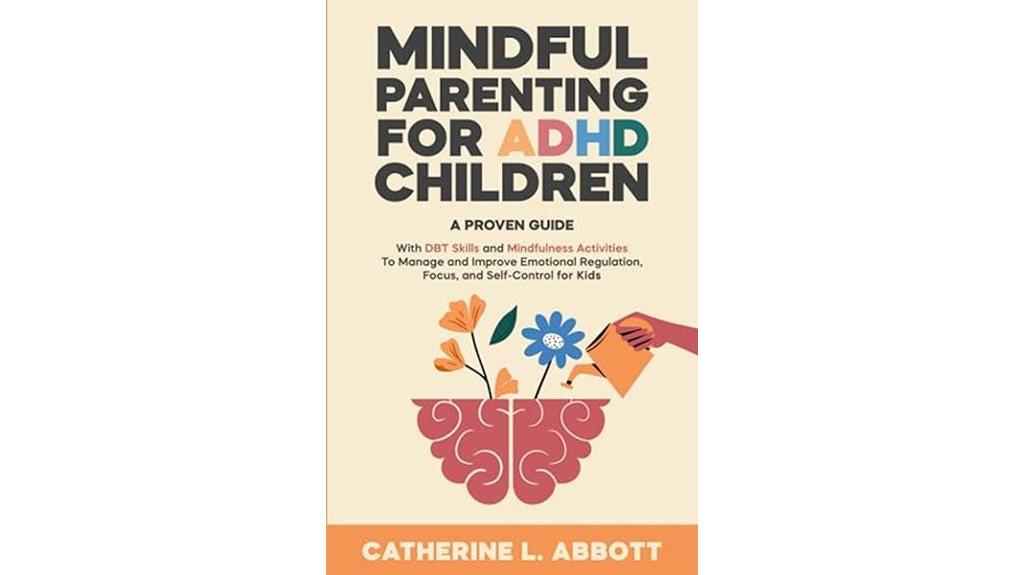
Ideal for parents seeking practical strategies to support children with ADHD, Mindful Parenting Books offer valuable insights and coping mechanisms. These books provide a holistic understanding of ADHD, covering symptoms, causes, and diagnosis. They equip parents with practical tools such as DBT skills and mindfulness activities to help children manage emotional regulation, focus, and self-control effectively.
Readers recommend these books not only for parents but also for foster parents, teachers, and individuals working with children dealing with ADHD. Personal experiences shared by readers highlight how these books have helped them navigate the challenges of raising children with ADHD, offering practical strategies and valuable coping mechanisms.
By promoting self-awareness, self-control, effective communication, and nurturing environments, Mindful Parenting Books play a significant role in fostering harmonious relationships between parents and children with ADHD.
Best For: Parents, foster parents, teachers, and individuals working with children with ADHD seeking practical tools and insights to support emotional regulation and self-control.
Pros:
- Comprehensive understanding of ADHD, including symptoms, causes, and diagnosis.
- Practical tools like DBT skills and mindfulness activities for managing emotional regulation and focus in children with ADHD.
- Empowers parents to create a nurturing environment fostering self-awareness and self-control in children with ADHD.
Cons:
- Subjective nature of content may not resonate with all readers.
- Similar strategies may be available online for free, raising concerns about the book's unique value.
- Some readers may find the content repetitive or lacking in depth in certain areas.
Mindful Parenting Book
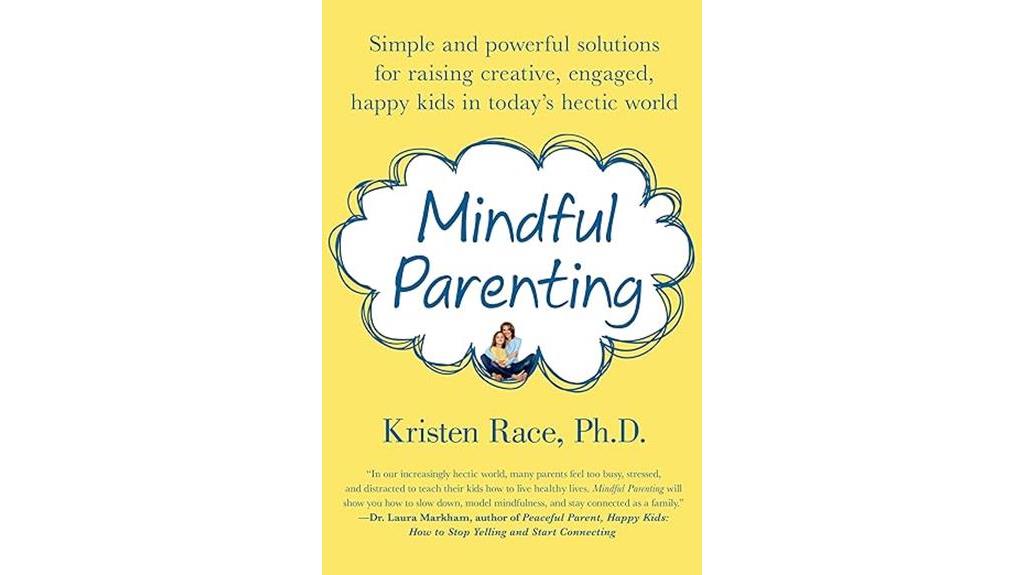
For parents seeking practical and science-backed strategies to explore mindfulness in their parenting approach, this book offers valuable insights and actionable advice. With numerous positive reviews praising its eye-opening content and practicality, this book seems to resonate with a wide range of readers.
It not only delves into understanding why children react the way they do but also provides tips for managing stress and improving mindfulness. Backed by scientific evidence, each chapter offers a blend of research-based information and mindfulness techniques, making it accessible even to those unfamiliar with complex biological concepts.
The book's practical suggestions and easy application have garnered recommendations from various readers, highlighting its global relevance beyond just American audiences. Whether you're a parent, grandparent, or anyone working with children, this book seems to offer a detailed guide to incorporating mindfulness into your parenting journey.
Best For: Parents and caregivers looking for practical, science-backed strategies to integrate mindfulness into their parenting approach.
Pros:
- Offers valuable insights and actionable advice for understanding children's behavior and managing stress.
- Backed by scientific evidence, providing a blend of research-based information and mindfulness techniques.
- Practical suggestions and easy application make it accessible to a wide range of readers, including those unfamiliar with complex biological concepts.
Cons:
- May not delve deep enough into certain advanced parenting topics.
- Could benefit from more diverse perspectives and cultural considerations.
- Some readers may find the content repetitive or overly simplistic.
Mindful Discipline: A Loving Approach to Setting Limits and Raising an Emotionally Intelligent Child
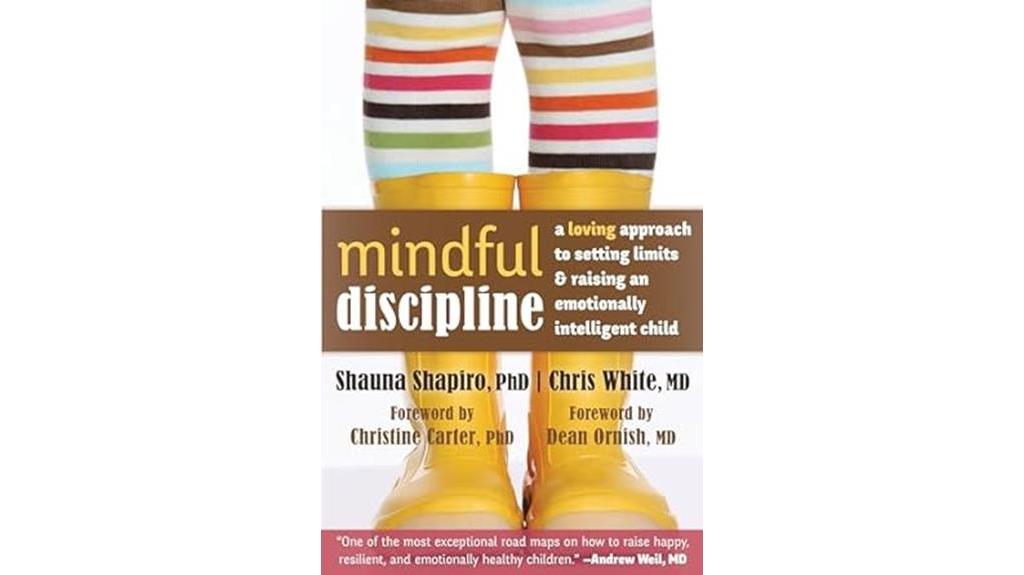
Best suited for parents seeking to incorporate mindfulness and loving discipline in their parenting approach, 'Mindful Discipline: A Loving Approach to Setting Limits and Raising an Emotionally Intelligent Child' offers practical strategies and insights for nurturing emotionally intelligent children. The book is praised for its common-sense approach, providing readers with tangible examples to follow.
By emphasizing mindfulness and balanced discipline, it equips parents with tools to raise children who are emotionally adept. Mindfulness benefits highlighted in the book include improved emotional regulation and resilience for both parents and children.
Readers appreciate the easy-to-implement strategies for setting boundaries and fostering a harmonious home environment. Though some desire more hands-on tips, the academic foundation of the book ensures a well-balanced and science-based approach to mindful parenting.
Best For: Parents looking to incorporate mindfulness and loving discipline in their parenting approach to raise emotionally intelligent children.
Pros:
- Practical strategies and tangible examples provided for nurturing emotionally intelligent children.
- Emphasis on mindfulness and balanced discipline to equip parents with effective tools.
- Easy-to-implement strategies for setting boundaries and fostering a harmonious home environment.
Cons:
- Some readers desire more hands-on tips and examples.
- Need for alternative strategies if initial suggestions do not work smoothly.
- Lack of practical advice and examples may leave some readers feeling the book falls short of expectations.
Parenting from the Inside Out: How a Deeper Self-Understanding Can Help You Raise Children Who Thrive

With its focus on deeper self-understanding to enhance parenting skills, 'Parenting from the Inside Out' is a valuable resource for those seeking to cultivate a strong and nurturing relationship with their children.
This book explores the importance of understanding one's own past and emotions to become a better parent. By investigating how our upbringing influences our parenting style, 'Parenting from the Inside Out' offers a fresh perspective on raising children.
It emphasizes the significance of healing past wounds and developing a deeper self-awareness to create a more empathetic and understanding environment for our children to thrive.
Through personal insights from professionals and scientific references, this book provides practical tools for self-growth and fostering stronger parent-child relationships.
If you're looking to enhance your parenting skills through inner reflection and understanding, 'Parenting from the Inside Out' is a must-read.
Best For: Individuals seeking to improve their parenting skills through deeper self-understanding and healing past wounds.
Pros:
- Offers valuable insights on how personal history influences parenting style.
- Provides practical tools and exercises for self-growth and fostering better parent-child relationships.
- Backed by personal insights from professionals and referenced scientific material for a comprehensive understanding.
Cons:
- May require a significant amount of introspection and emotional work.
- Some readers might find the psychological concepts challenging to grasp initially.
- Not a quick-fix solution and requires ongoing commitment to personal growth and reflection.
Under the Chinaberry Tree: Books and Inspirations for Mindful Parenting
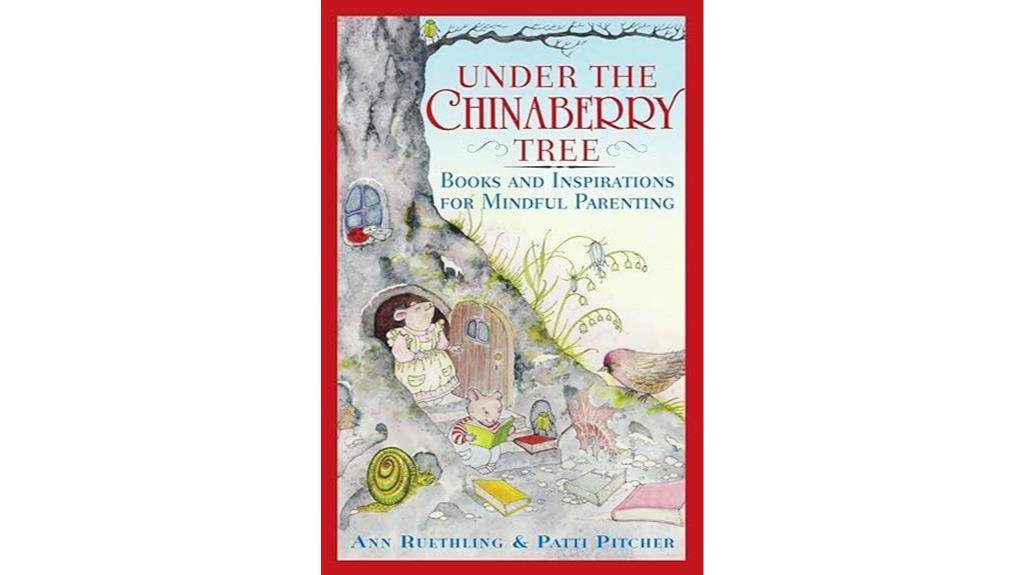
When considering books for mindful parenting, exploring 'Under the Chinaberry Tree' can provide valuable insights and inspirations for traversing the journey of raising young children. This book has garnered positive reviews for its comforting and valuable content, appreciated by fans of Chinaberry's offerings.
Ann's wisdom and humor shine through, making it a recommended read for all parents of young children. Despite some critiques about its focus on specific age groups and design elements, the book's teachings on parenting from the heart and soul have left a lasting impact on readers.
Through personal growth and a unique perspective, 'Under the Chinaberry Tree' has influenced many to become better parents. Sharing personal experiences and recommendations, this book serves as a guiding light for mindful parenting.
Best For: Parents seeking valuable insights and inspirations for mindful parenting to navigate the journey of raising young children.
Pros:
- Offers comforting and valuable content appreciated by fans of Chinaberry's offerings.
- Provides teachings on parenting from the heart and soul, impacting personal growth and perspective.
- Recommended read for all parents of young children, influencing better parenting skills.
Cons:
- Critiques regarding the focus on specific age groups in the book.
- Some children may not find recommended books appealing.
- Design elements such as detailed illustrations and the green typeface may impact engagement and readability.
Growing Up Mindful
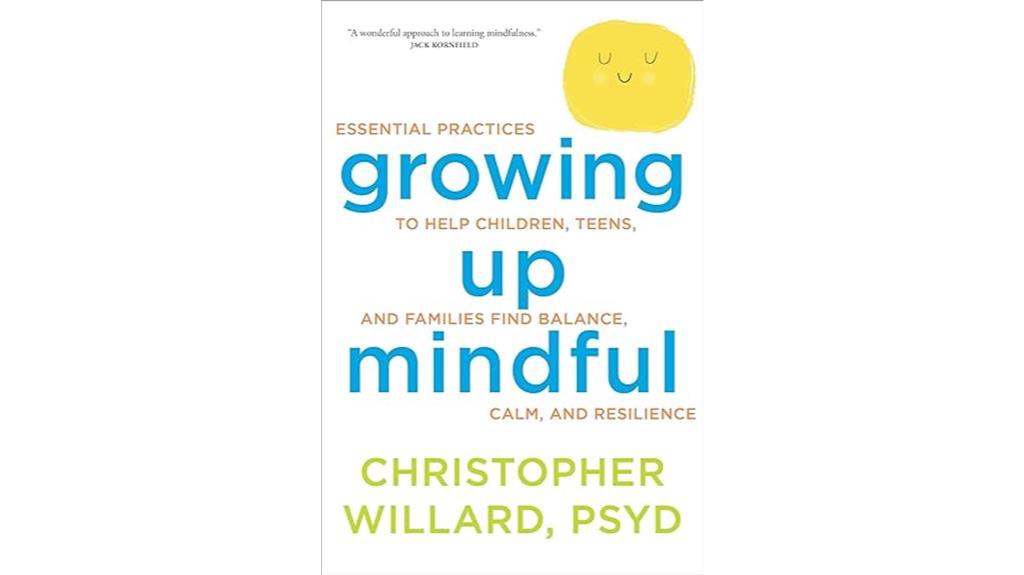
For parents, teachers, therapists, caregivers, or anyone interested in sharing mindfulness with children, 'Growing Up Mindful' offers easily implemented practices and a positive outlook on teaching mindfulness to kids. This book provides a variety of practical suggestions that are clear, easy to follow, and suitable for individuals at all experience levels.
It includes a helpful chart showcasing the positive impact of regular mindfulness practice, making it a valuable resource for those looking to introduce mindfulness into children's lives. With a writing style that's genuine and easy to understand, 'Growing Up Mindful' incorporates mindful interludes for experiential learning, enhancing the overall reading experience.
Users have praised this book as one of the best resources for teaching mindfulness to children, making it a must-have for anyone interested in incorporating mindfulness practices into their families or classrooms.
Best For: Parents, educators, therapists, and caregivers seeking a comprehensive and user-friendly guide for teaching mindfulness to children.
Pros:
- Easily implemented practices suitable for beginners and experienced individuals.
- Genuine writing style with mindful interludes for experiential learning.
- Positive impact chart showcasing the benefits of regular mindfulness practice.
Cons:
- Some users reported receiving books with stains upon arrival.
- One user recommended purchasing the physical copy over the digital version.
- Limited mention of potential challenges or obstacles in implementing mindfulness practices with children.
Practicing Mindfulness: 75 Essential Meditations to Reduce Stress, Improve Mental Health, and Find Peace
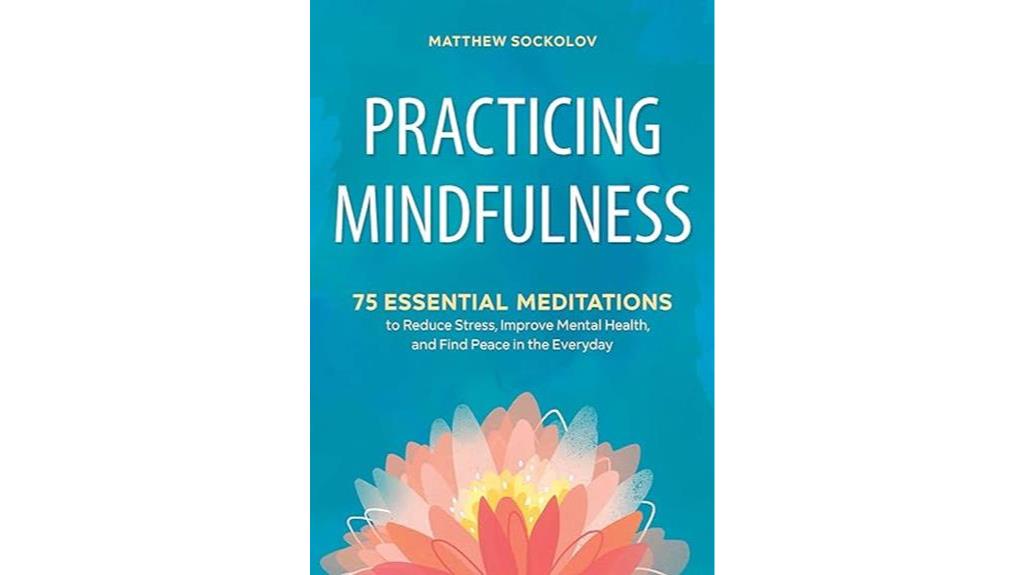
Ideal for busy parents seeking quick and effective mindfulness practices, 'Practicing Mindfulness: 75 Essential Meditations to Reduce Stress, Improve Mental Health, and Find Peace' offers accessible techniques tailored for daily use. This book by Mathew Sockolov presents a wide range of meditation approaches designed to fit into even the busiest schedules, with sessions lasting between 5 to 20 minutes.
It covers areas such as basic mindfulness exercises, everyday mindfulness, and mindful moods, making it a thorough guide for self-improvement through meditation. Readers have praised its simplicity, readability, and practicality in incorporating meditation into their daily routines.
Whether you're new to mindfulness or a seasoned practitioner, this book provides valuable resources for managing emotions and stress effectively in everyday life.
Best For: Individuals with busy schedules seeking accessible and effective mindfulness practices.
Pros:
- Offers a wide range of meditation approaches suitable for daily use.
- Simple and practical exercises that take little time to complete.
- Comprehensive guide covering various areas for self-improvement through meditation.
Cons:
- Some may find the meditation ideas presented overly simplistic.
- Content may not be deemed substantial enough for certain preferences.
- A perception of the material being more suitable for a blog post or series rather than a book.
The Book of Joy: Lasting Happiness in a Changing World
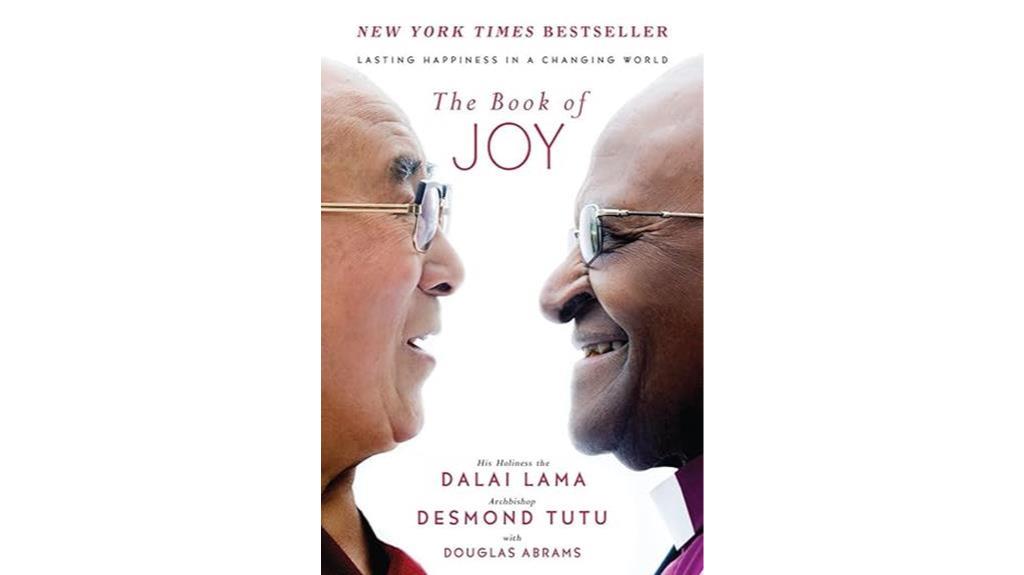
Exploring 'The Book of Joy: Lasting Happiness in a Changing World' offers valuable insights for parents seeking to cultivate compassion and empathy in their parenting journey. Published in 2016, this book documents a remarkable week-long meeting between the Dalai Lama and Archbishop Desmond Tutu, focusing on the pursuit of joy amidst life's challenges.
Divided into three parts, it covers the essence of true joy, the barriers to joy, and the pillars of joy. Delving into topics like suffering, forgiveness, and compassion, the book provides practical advice on finding happiness and maintaining mental well-being.
Readers appreciate the wisdom, humor, and depth of humanity portrayed in this book, making it a recommended read for those looking to enhance their personal growth and embrace joy in an ever-changing world.
Best For: Parents seeking to instill compassion and empathy in their parenting journey through profound insights on joy and resilience.
Pros:
- Offers practical advice on finding happiness and maintaining mental well-being.
- Delightful blend of wisdom, humor, and humanity.
- Insightful exploration of joy amidst life's challenges.
Cons:
- May require reflection and introspection, which can be time-consuming.
- Some readers may find the content emotionally intense.
- Not a quick-fix solution for immediate happiness.
Beginners Guide on Parenting Children with ADHD: Modern Approach to Understanding and Leading Hyperactive Child to Success
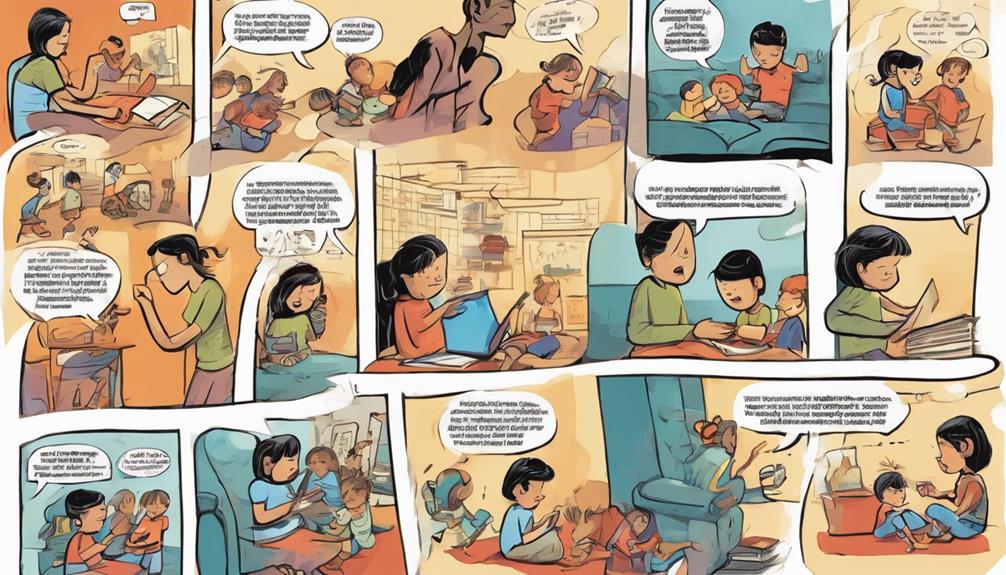
When seeking a practical and insightful guide on parenting children with ADHD, 'Mindful Parenting Books' stands out as a valuable resource. This book has garnered positive reviews for its helpful content and modern approach to dealing with ADHD.
While it may lack concrete suggestions on how to help kids with ADHD according to some critics, it's still praised for its clear and concise style, making it great for beginners. Some readers appreciate the perspective offered by the knowledgeable author, although a few feel it could benefit from more practical advice.
Overall, the book emphasizes the importance of wise parenting in guiding ADHD children and incorporates successful therapy methods that have been well-received. Published in 2021, it provides up-to-date information compared to older resources.
Best For: Parents seeking a modern and beginner-friendly approach to understanding and guiding children with ADHD.
Pros:
- Provides valuable content and a modern approach to dealing with ADHD.
- Clear and concise, great for beginners.
- Emphasizes the importance of wise parenting in guiding ADHD children.
Cons:
- Lacks concrete suggestions on how to help kids with ADHD.
- Some find it upsetting to refer to ADHD as an illness.
- Needs more practical advice on what to do instead of what not to do.
Being at Your Best When Your Kids Are at Their Worst: Practical Compassion in Parenting
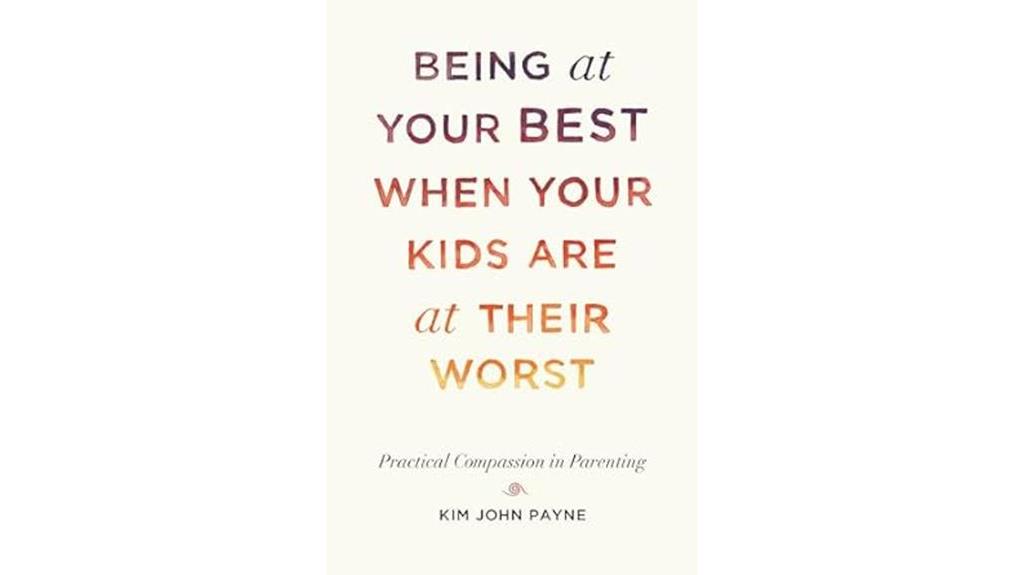
For parents seeking practical guidance on maintaining composure and showing compassion during challenging parenting moments, 'Being at Your Best When Your Kids Are at Their Worst: Practical Compassion in Parenting' stands out as a valuable resource. This book has garnered positive reviews and recommendations for its practical advice and approachable writing style. Readers appreciate the concise and helpful nature of the content, along with the author's use of personal experiences in education.
Despite these strengths, some concerns have been raised regarding the book's applicability to children with attachment issues like Reactive Attachment Disorder. Additionally, a few readers feel that the parenting approaches presented may oversimplify complex behavioral challenges.
However, the book's focus on compassion and empowering parenting techniques remains a highlight, with many sharing how it has helped improve their relationships with their children and reduce conflicts within the family.
Best For: Parents looking for practical and compassionate parenting guidance during challenging moments with their children.
Pros:
- Practical advice and approachable writing style.
- Concise and helpful content with practical tools for parenting.
- Focus on compassion and empowering parenting techniques.
Cons:
- Lack of accommodation for children with attachment issues like Reactive Attachment Disorder.
- Oversimplification of parenting approaches may not suit children with deep behavioral challenges.
- Heavy use of metaphors and catchphrases in the book.
Parenting at Your Best: Powerful Reflections and Straightforward Tips for Becoming a Mindful Parent
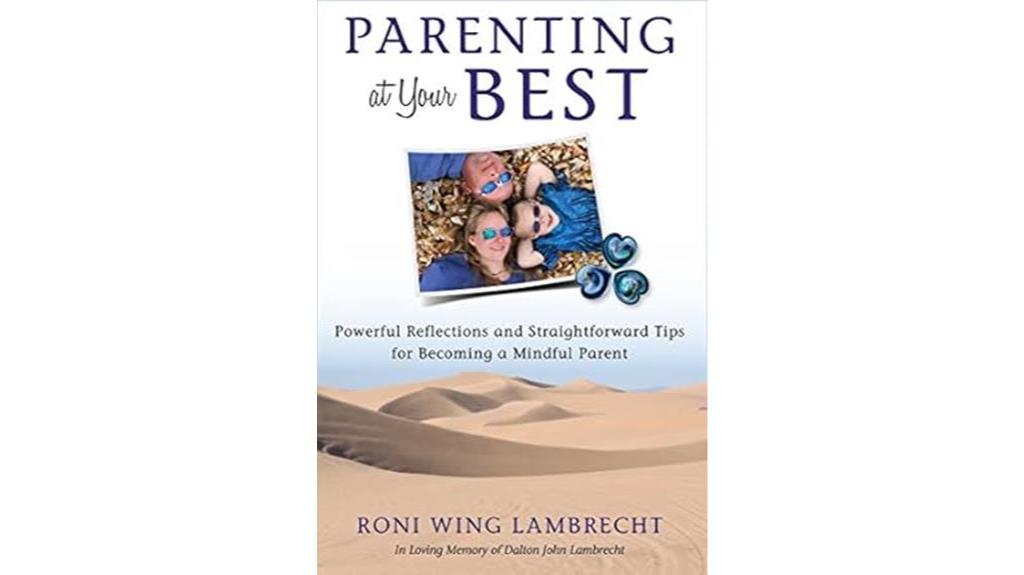
This book, Parenting at Your Best, is a valuable resource for new and soon-to-be parents as well as those who've experienced loss, offering powerful reflections and practical tips for mindful parenting.
Written by Roni Wing Lambrecht, the book draws from the author's personal journey through grief after losing her teenage son, Dalton. It emphasizes the importance of intentional parenting and treasuring moments with our children.
The book focuses on making each parenting moment meaningful, highlighting the significance of respect in parent-child relationships. It provides straightforward and down-to-earth advice, promoting inclusivity and open communication within families.
Readers have found the book to evoke a range of emotions, from smiles to tears, while offering practical and heartfelt guidance for reflecting on parenting approaches.
Overall, Parenting at Your Best is praised for its sincerity, practicality, and ability to resonate with parents looking to enhance their parenting skills.
Best For: Parents looking to enhance their parenting skills and embrace mindful parenting practices.
Pros:
- Offers powerful reflections and practical tips for mindful parenting.
- Written by an author who shares personal experiences and wisdom.
- Emphasizes the value of respect in parent-child relationships.
Cons:
- May evoke strong emotional responses in readers, including tears.
- Focuses on grief and loss, which may be challenging for some readers.
- Some readers may find the approach too sentimental or emotional.
The Mindful Parent
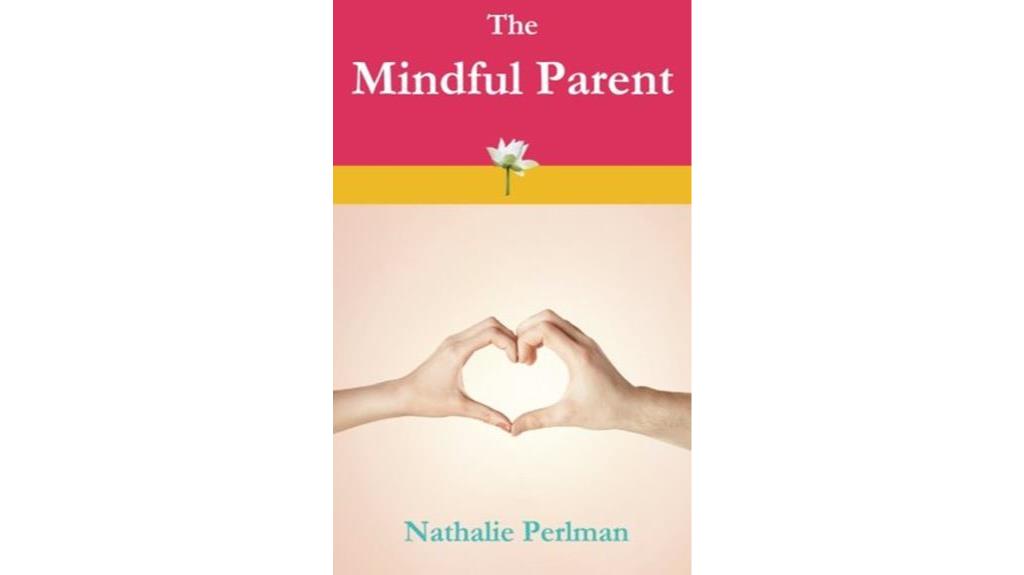
Exploring 'The Mindful Parent' offers valuable insights and practical strategies for parents seeking to cultivate stronger parent-child relationships through mindfulness. This book emphasizes the importance of shifting one's mindset to enhance the dynamics with their children.
It provides actionable tips on incorporating mindfulness into parenting practices to foster better connections and personal development. Despite a few typographical errors, readers have generally appreciated the informative and concise nature of the book.
Readers commend it as essential reading for all parents, praising its ability to offer guidance and help them embrace their parental responsibilities. While some readers have noted the need for better editing and felt the book leaned too heavily on promoting mindful parenting, overall, it's recommended for those looking to enrich their parenting journey with mindfulness principles.
Best For: Parents looking to deepen their bond with their children through mindful practices.
Pros:
- Offers practical tips for applying mindfulness to parenting.
- Emphasizes the importance of changing one's mindset for better parent-child relationships.
- Provides insightful information for personal growth and enhancing parenting skills.
Cons:
- Contains typographical errors that may be distracting.
- Some readers feel it focuses too much on selling the concept of mindful parenting.
- Implementation tips could be more extensive for practical application.
Factors to Consider When Choosing Mindful Parenting Books

When selecting mindful parenting books, it's crucial to take into account key selection criteria such as the author's expertise and the book's reputation.
Assessing the content, reader engagement levels, and practical application tips within the book can help ascertain its usefulness for your parenting journey.
Search for impactful parenting techniques that align with your values and parenting style to make the most of your reading experience.
Key Selection Criteria
Taking into account the author's background and expertise in parenting, mindfulness, or child psychology is vital when selecting mindful parenting books. Authors with experience in these areas are more likely to provide valuable insights and practical advice that can resonate with your parenting journey.
It's essential to look for books that offer practical tips, techniques, and strategies for mindful parenting, as these can be directly applied to your daily interactions with your children. Checking for recommendations or reviews from other parents, educators, or professionals in the field can also give you a better understanding of the book's effectiveness and relevance.
Consider the specific focus of the book, such as ADHD parenting, emotional intelligence, or mindfulness practices, to make sure it aligns with your current needs and challenges. Evaluating the readability and engaging nature of the book is important to make sure that it complements your parenting style and preferences, making the learning process more enjoyable and effective.
Book Content Evaluation
Considering the practicality and relevance of the content is essential when selecting mindful parenting books. It's important to evaluate the depth of insights and wisdom shared by the authors, as well as the presence of personal experiences and relatable anecdotes within the book.
Additionally, looking at how the content aligns with your specific parenting needs and challenges is crucial. Examining the author's background and expertise can provide insight into the basis of their advice, helping you determine the credibility of the information presented.
When evaluating book content, focus on practical tips and strategies offered for implementing mindful parenting, seeking a balance between theory and actionable guidelines. Consider whether the information provided aligns with your parenting goals and values, and if the book addresses common parenting challenges relevant to your family dynamics.
Checking reader feedback can also offer valuable insights into how the book's content has helped others improve their parenting skills and relationships with their children.
Reader Engagement Levels
To choose mindful parenting books effectively, it's important to assess the levels of reader engagement, which play a significant role in the book's impact on implementing mindfulness techniques in parenting.
Engaging content is crucial as it keeps readers interested and motivated to apply the teachings within the book. Interactive elements such as exercises, worksheets, and reflection prompts can enhance engagement by encouraging active participation. Additionally, personal anecdotes and relatable stories can resonate with readers, making the content more relatable and engaging.
Books that offer practical, actionable advice tend to engage readers more effectively in applying mindfulness techniques in parenting situations. Reader engagement levels can be gauged by the emotional responses evoked, such as tears, inspiration, and reflection. Positive feedback from readers praising the book's impact and practical advice is a strong indicator of high engagement levels.
Furthermore, personal experiences shared by readers and recommendations based on practicality and value demonstrate a deep connection and high level of engagement with the book's content.
Practical Application Tips
Practical application tips found in mindful parenting books serve as invaluable resources for parents seeking to implement mindfulness techniques in their day-to-day interactions with their children. These tips offer step-by-step guidance on applying mindfulness practices in various parenting challenges. They provide concrete strategies for enhancing self-awareness, managing emotions, and fostering positive communication with kids. Often, these tips include exercises, reflection prompts, and real-life examples to illustrate effective mindful parenting.
Impactful Parenting Techniques
When choosing mindful parenting books, it's essential to ponder the specific impactful parenting techniques they offer to enhance your relationship with your child.
Effective parenting techniques focus on building strong parent-child relationships and fostering emotional intelligence. Mindful parenting involves practicing self-awareness, empathy, and compassion towards oneself and children.
Techniques such as active listening, setting boundaries with empathy, and modeling positive behaviors are key in mindful parenting. Mindfulness practices like deep breathing, meditation, and self-reflection help parents respond calmly to challenging situations.
These techniques promote emotional regulation, communication skills, and positive behavior modeling for children.
Building strong parent-child relationships based on respect, open communication, and emotional connection is vital.
Being present in the moment, actively listening to your children, setting boundaries with love and consistency, and encouraging self-awareness and emotional regulation are fundamental in mindful parenting.
Positive discipline strategies that prioritize teaching and guiding children are also emphasized.
Frequently Asked Questions
How Can Mindful Parenting Help With Managing ADHD in Children?
Mindful parenting can benefit children with ADHD by fostering increased self-awareness and emotional regulation. By practicing mindfulness techniques, parents can help children manage impulsivity and improve attention span.
Mindful parenting also promotes open communication, patience, and empathy, which are essential in supporting children with ADHD. Setting clear boundaries and consistent routines in a mindful manner can create a stable environment that aids in managing ADHD symptoms effectively.
What Are the Key Differences Between Mindful Discipline and Traditional Discipline?
Mindful discipline emphasizes understanding a child's emotions and encourages positive behavior through communication. Traditional discipline often focuses on punishment and obedience.
By fostering empathy and connection, mindful discipline builds a child's self-regulation skills and strengthens the parent-child bond. In contrast, traditional discipline may lead to power struggles and resentment.
Incorporating mindfulness techniques, such as deep breathing and active listening, can enhance the effectiveness of discipline strategies and promote a harmonious parent-child relationship.
How Can Mindfulness Practices Benefit Parents During Childbirth and Beyond?
Mindfulness practices offer parents invaluable tools during childbirth and beyond. By cultivating present moment awareness and non-judgmental acceptance, parents can navigate the challenges of labor with greater calm and focus.
Post-birth, mindfulness aids in managing stress, enhancing bonding with the newborn, and fostering emotional resilience. This practice enables parents to respond to their child's needs mindfully, promoting healthy relationships and effective communication.
Ultimately, mindfulness supports parental well-being and nurtures a harmonious family dynamic.
Are There Specific Mindfulness Techniques Tailored for Raising Emotionally Intelligent Children?
Mindfulness techniques can be adapted to nurture emotionally intelligent children. Practices like active listening, empathy modeling, and teaching emotional regulation skills are key.
Mindful breathing exercises can help kids manage big emotions. Setting a calm environment and encouraging open communication foster emotional intelligence.
How Do Mindful Parenting Books Contribute to Self-Understanding and Improved Parent-Child Relationships?
Mindful parenting books serve as guiding lights, illuminating the path to self-discovery and deeper parent-child connections. By delving into these insightful texts, one can uncover hidden aspects of themselves and understand how their actions influence relationships.
These resources offer practical tools and perspectives that foster empathy, communication, and mutual respect within families. Through self-reflection and newfound knowledge, parents can cultivate stronger bonds with their children, nurturing understanding and harmony in their interactions.
Are the Books in the Mindful Parenting List Still Relevant and Worth Reading in 2024?
Looking for the best parenting books in 2024? The books in the Mindful Parenting list are still relevant and worth reading. With timeless advice on raising children in the digital age, fostering empathy, and maintaining a balanced family life, these books remain essential for parents navigating the challenges of modern parenting.
Conclusion
As parents, we're like gardeners nurturing our children, planting seeds of mindfulness and compassion. By reading the best mindful parenting books, we equip ourselves with the tools to cultivate a peaceful and harmonious environment for our families to thrive.
Just as a well-tended garden flourishes with care and attention, so too can our children bloom into resilient and compassionate individuals with the guidance provided by these insightful books.
-

 Parenting Styles1 week ago
Parenting Styles1 week agoWorst Parenting Style: Impact on Child Development
-
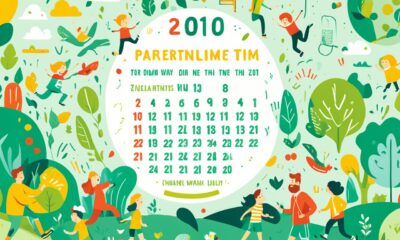
 Parenting Styles1 week ago
Parenting Styles1 week ago2023 Indiana Parenting Time Guidelines Update
-

 Vetted7 days ago
Vetted7 days ago15 Best Books on Step Parenting Every Blended Family Needs to Read
-

 Parenting Tips6 days ago
Parenting Tips6 days agoUnequal Responsibilities: When One Parent Does All the Parenting
-

 Parenting Tips1 week ago
Parenting Tips1 week agoFostering Love: How Much Do You Get Paid for Foster Parenting?
-

 Vetted22 hours ago
Vetted22 hours ago15 Best Co-Parenting Books Every Parent Should Read for Successful Co-Parenting
-

 Vetted6 days ago
Vetted6 days ago15 Best Parenting Books of All Time Every Parent Should Read
-

 Vetted6 days ago
Vetted6 days ago15 Best Books for Gentle Parenting Every Parent Should Read
